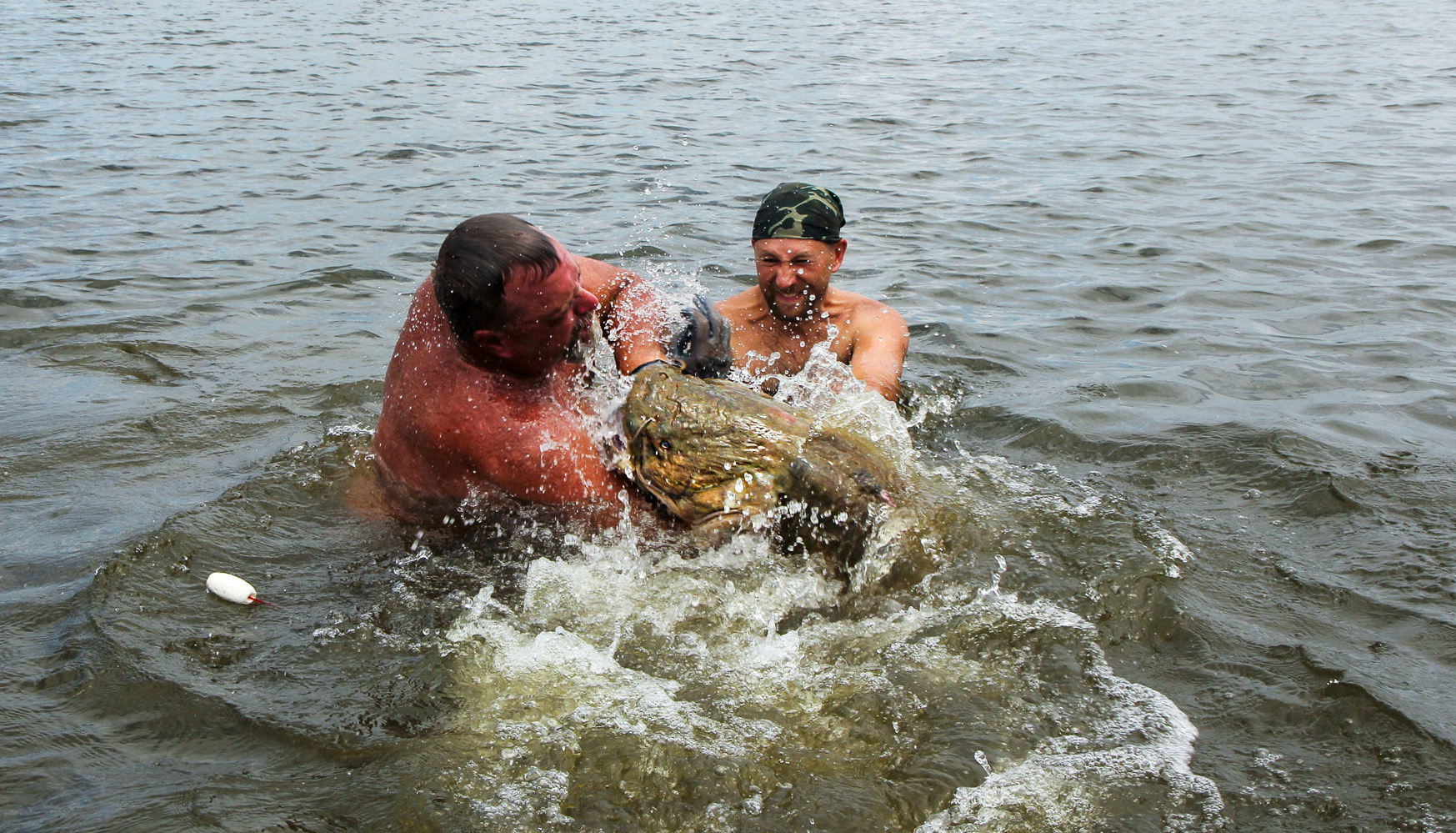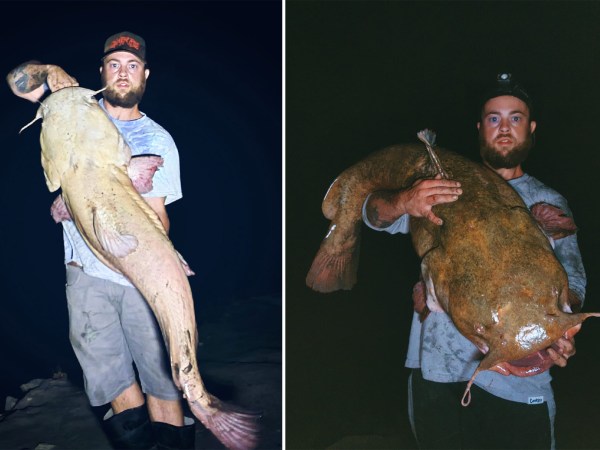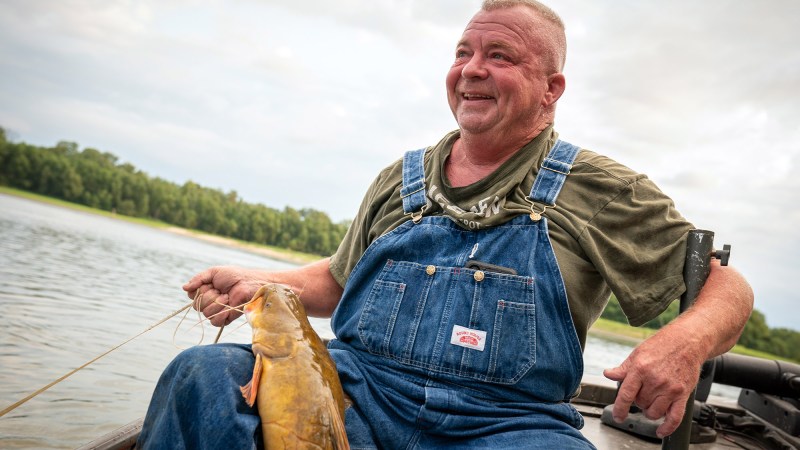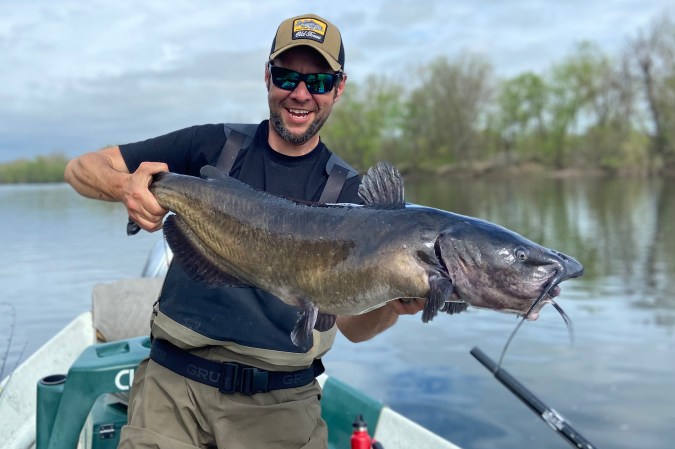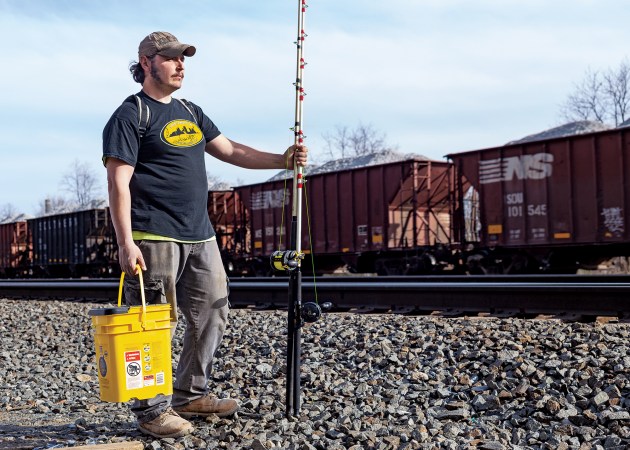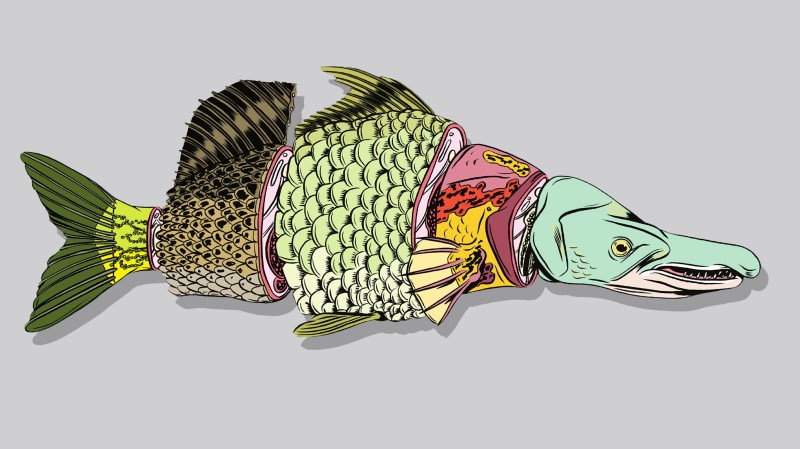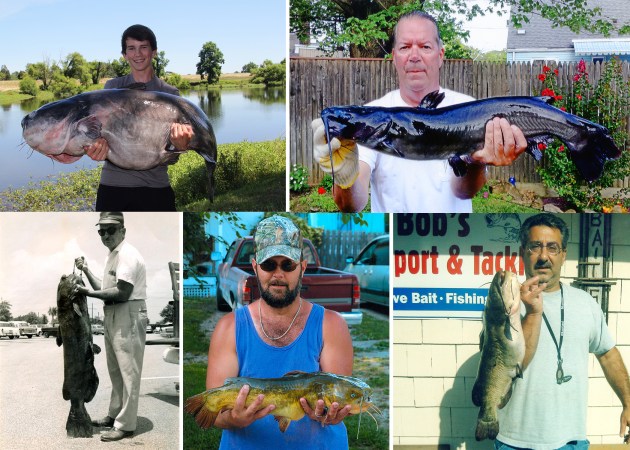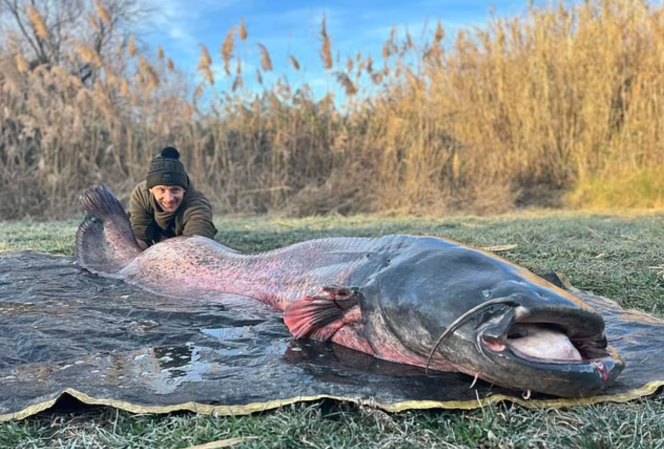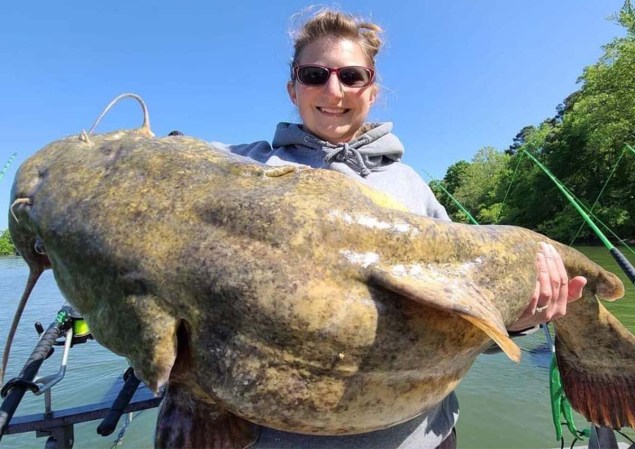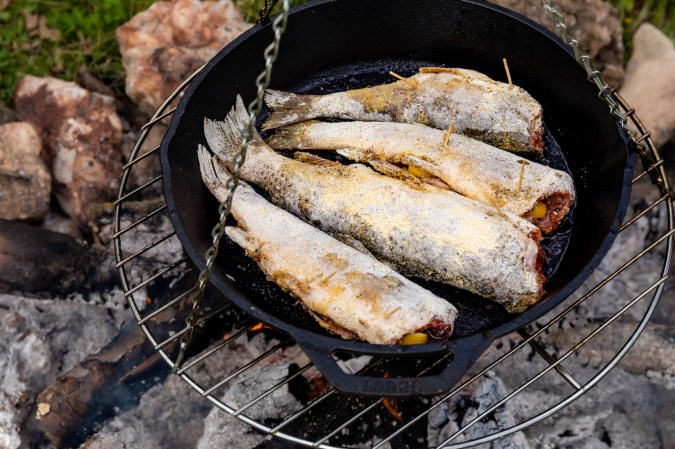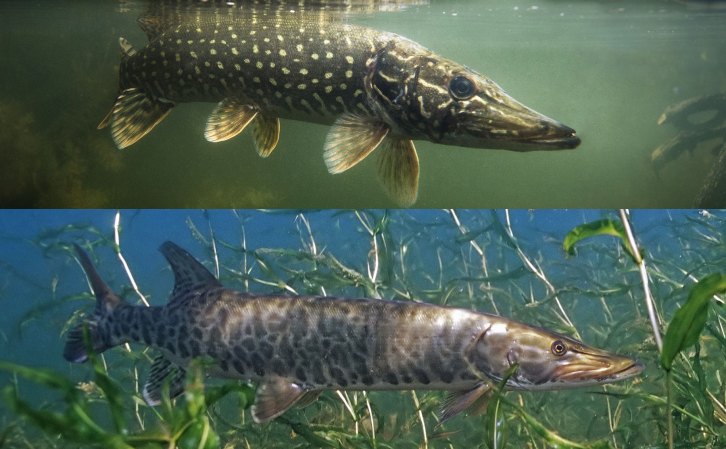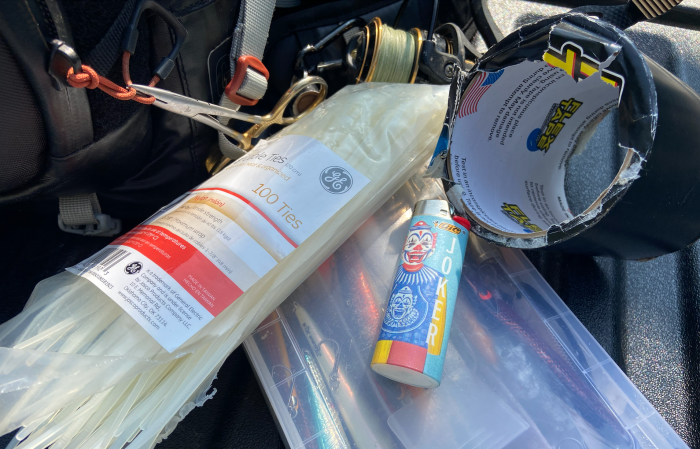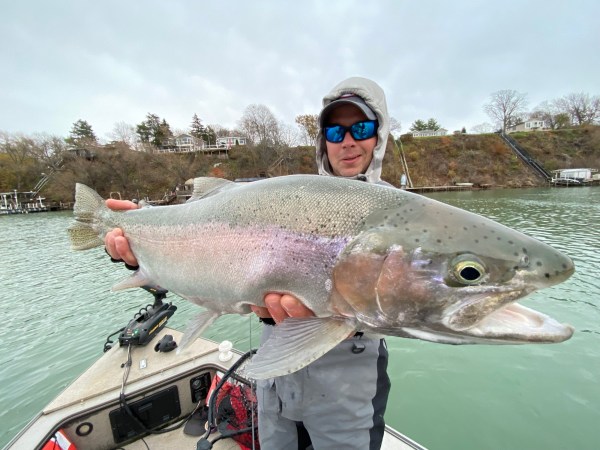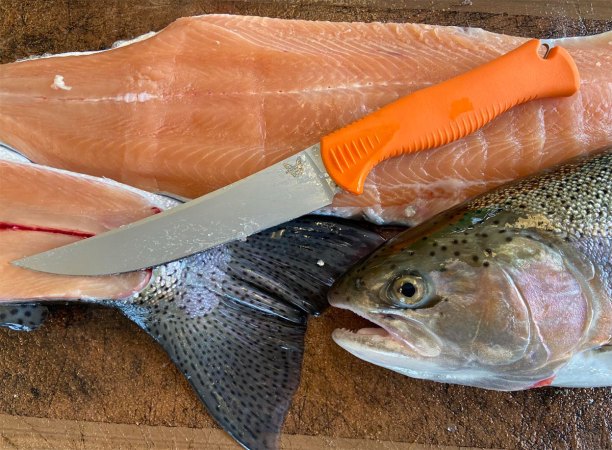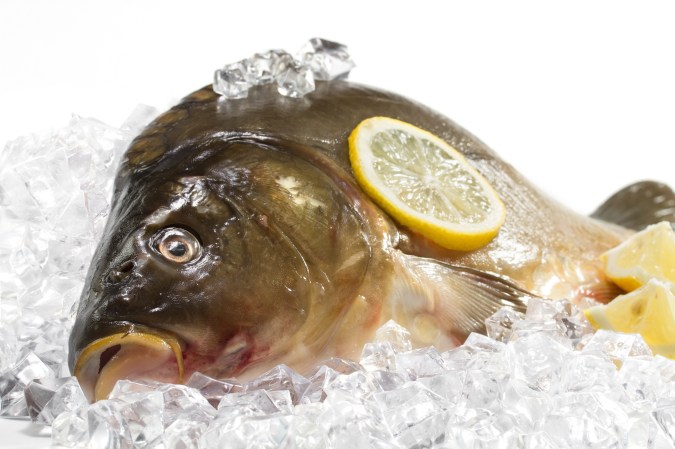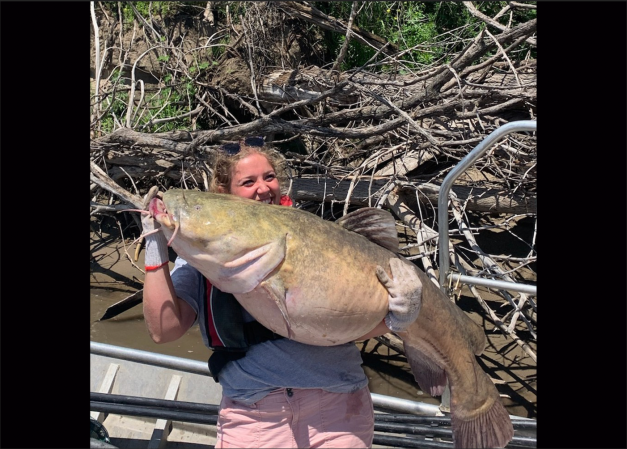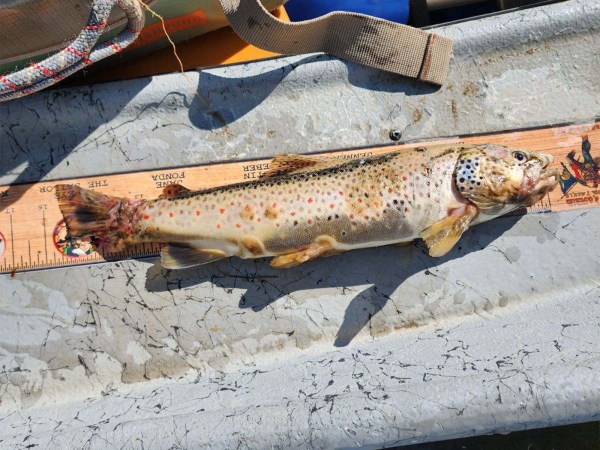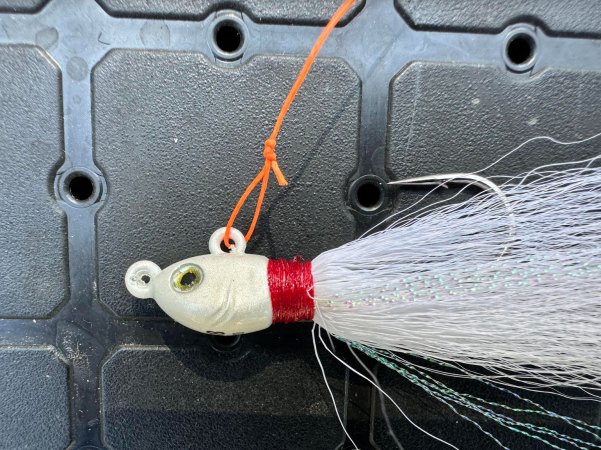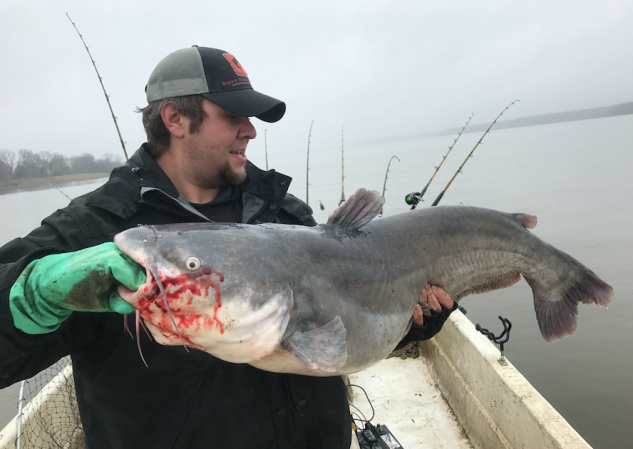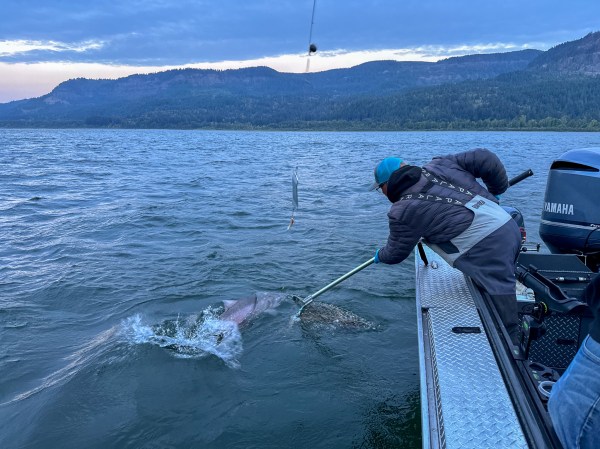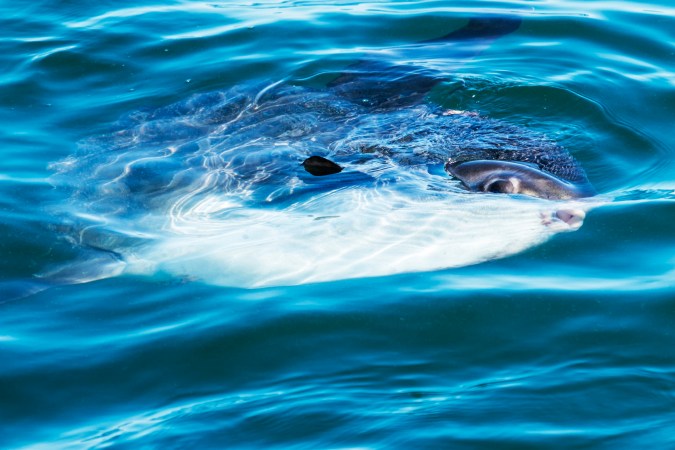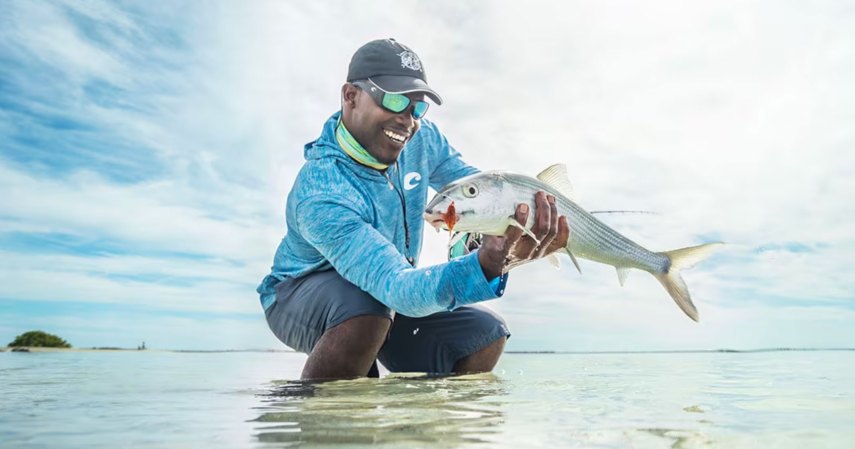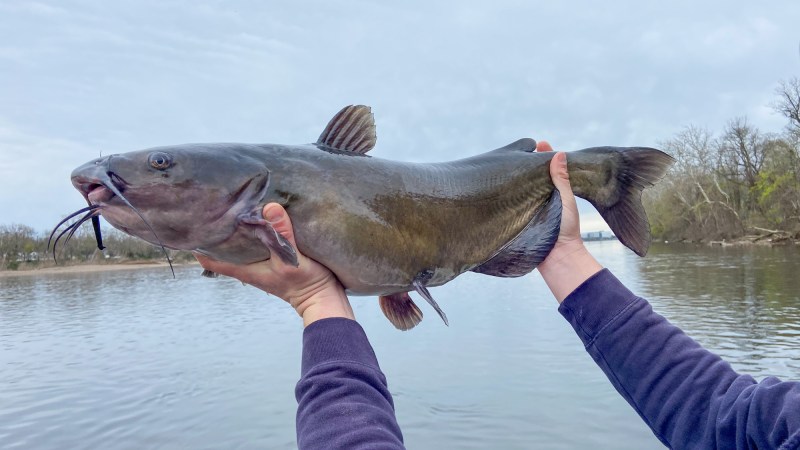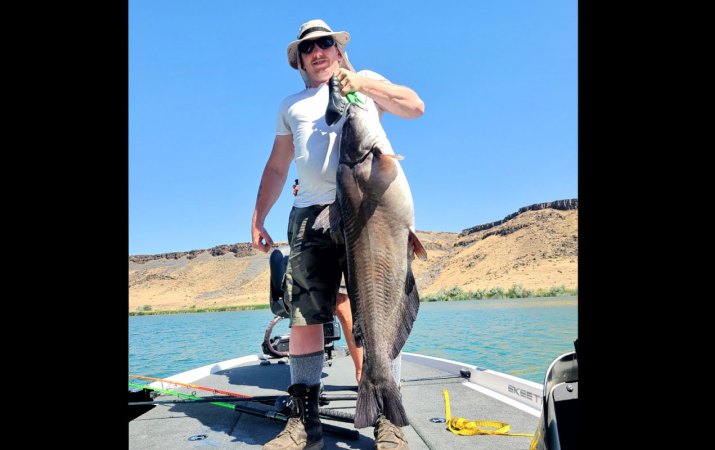We may earn revenue from the products available on this page and participate in affiliate programs. Learn More ›
When a big flathead bites your hand, your buddies wading nearby can feel the thump reverberate through the water. That telltale sound means a few things to them. First, the catfish hole you just swam down to check is indeed occupied. Second, you are probably thrashing around down there trying to haul that fish out before you have to come up for air. And third, they better be ready to help the moment your head breaks the surface.
There’s no denying that catfish noodling is an insane sport, or that it’s the most fun you’ll ever have catfishing—if you’ve got enough redneck in you to give it a try. More states have begun legalizing catfish noodling in recent years, and more people are interested in learning the unorthodox method. Here’s a complete guide to finding and catching catfish with your hands.
In This Article
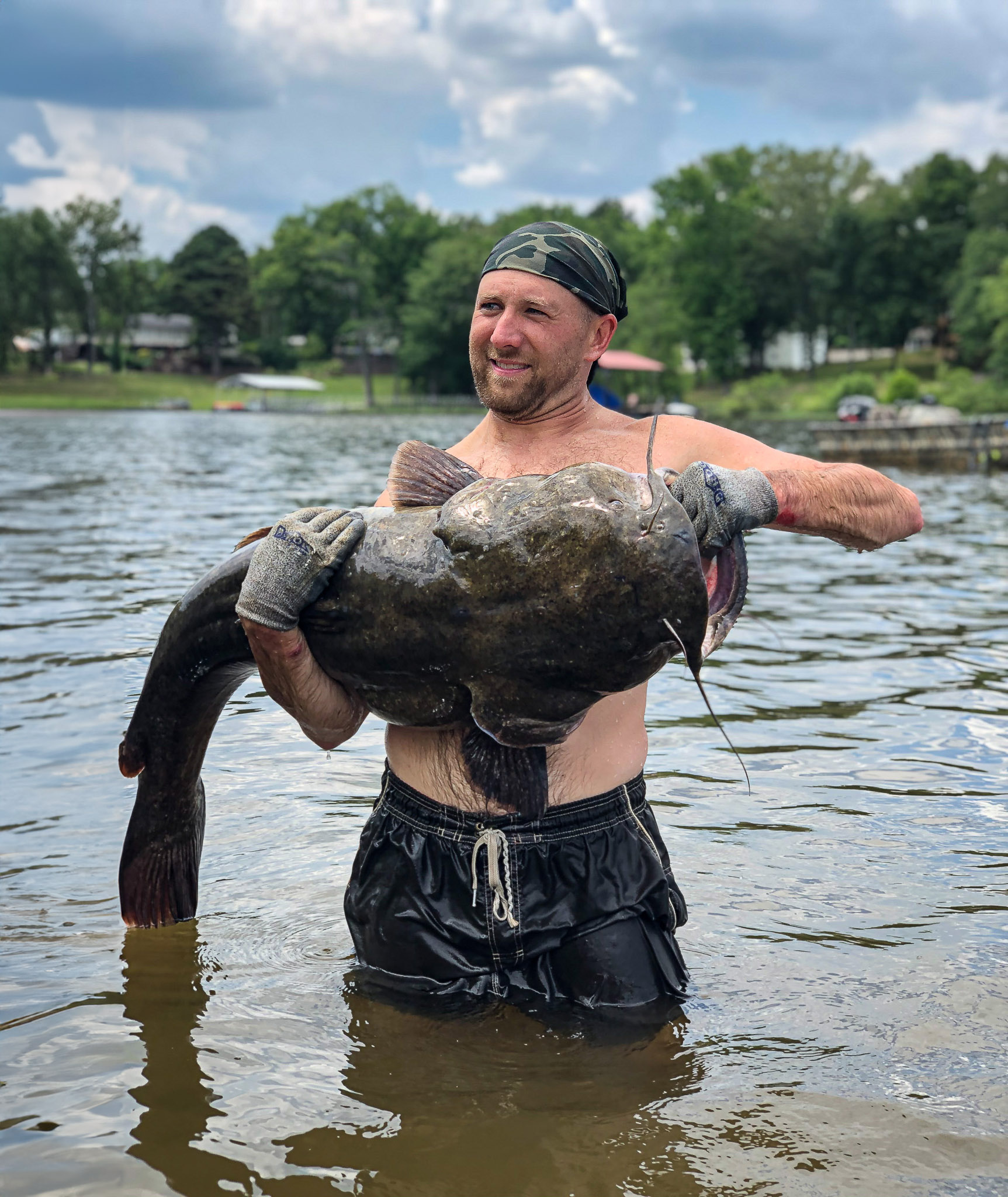
While I’ve noodled flatheads on more than one occasion—I learned in Kentucky from Will Brantley, Field & Stream’s hunting editor and resident noodling authority—I also spoke with two fisheries biologists for this article. You can read through this guide from start to finish, or you can jump around by clicking on one of these topics:
- What Is Catfish Noodling?
- Catfish Noodling Regulations and Ethics
- Gear for Noodling Catfish
- How to Catch a Catfish with Your Hands
- Is Noodling Catfish Dangerous?
- Understand Catfish Spawning Behavior to Find Fish
- The Rise of Noodling Culture
- FAQs
What Is Catfish Noodling?
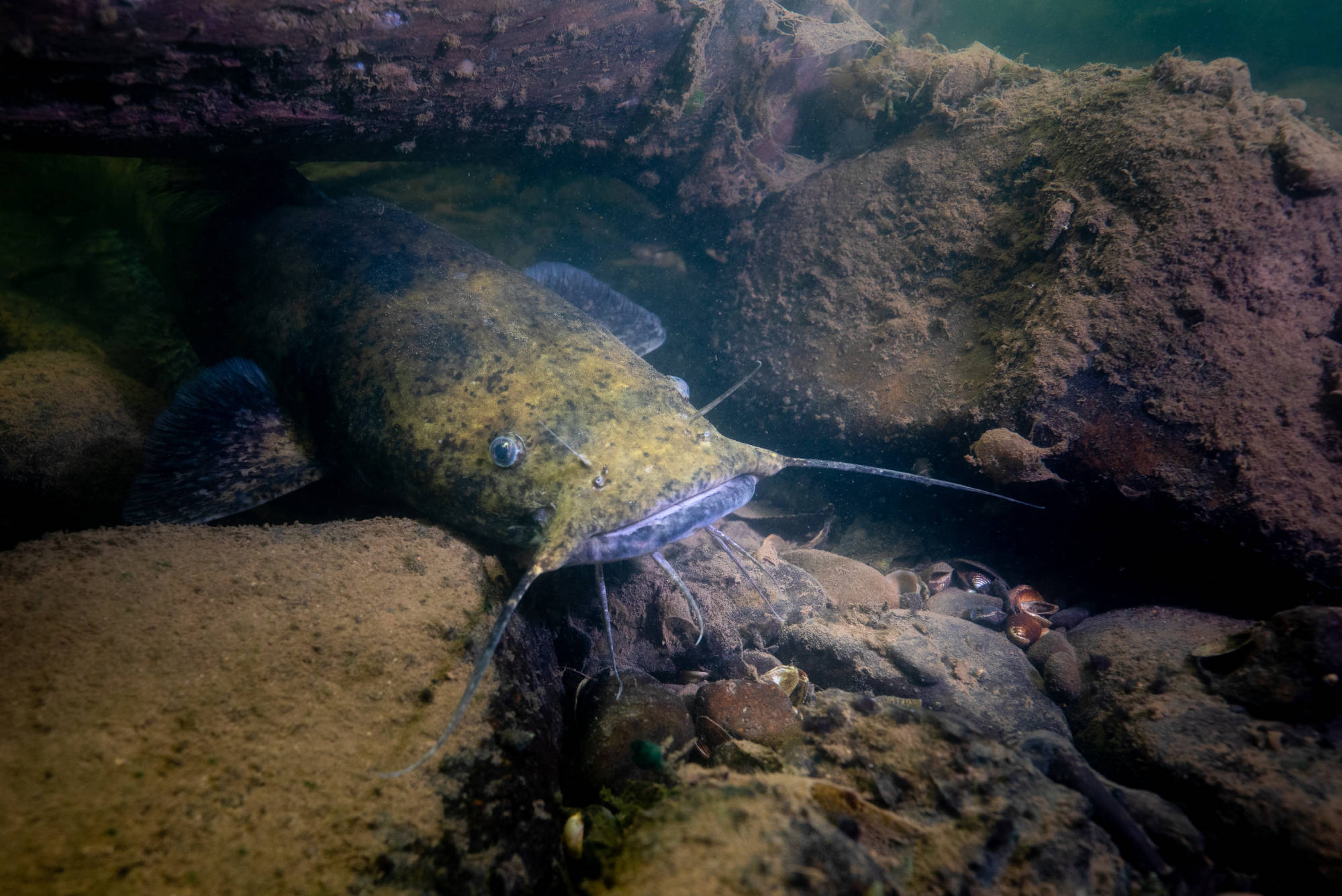
In its most basic form, noodling simply means catching a fish with your hands. Usually that fish is a catfish, though turtles and rough fish like carp may also be caught by hand in some states. Depending where you fish, noodling catfish is most productive from late May through July, when catfish hole up in natural and man-made cavities to spawn and guard eggs. That makes them extra feisty, and extra fun for noodlers to try to wrestle to the surface.
Note that in some states, noodling actually refers to methods of catching catfish with non-traditional equipment. In Arkansas, noodling entails using a snare device or a breakaway pole to catch catfish. In other places, it refers to using foam pool-noodle jugs to catch catfish on juglines. For the purposes of this article, we’ll cover the hand-fishing method only.
Noodling Regulations and Ethics
In places where noodling is legal—primarily the South and Midwest—regulations vary widely from state to state. Noodling catfish is considered a primitive or alternative method of take, and is usually found alongside other traditional catfishing methods like trotlining, juglining, and yoyoing in fishing regulation booklets.
Keep in mind that states regulate grabbing catfish differently. For instance, Oklahoma defines “noodling” as using only your hands to catch catfish. Meanwhile, the neighboring state of Arkansas calls that same practice “hogging.” and defines “noodling” as using special gear to take a fish.
Where Is Noodling Legal?
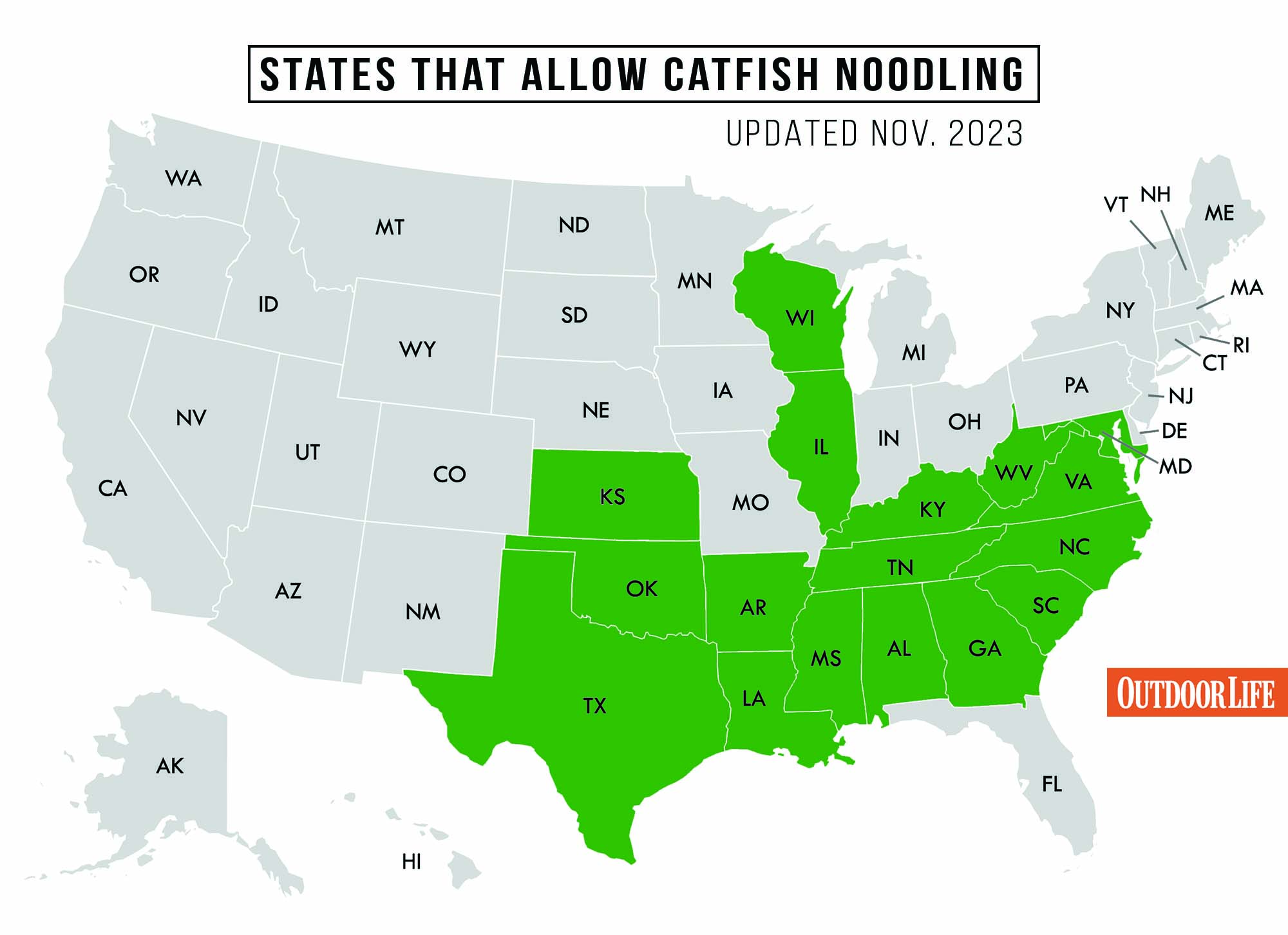
In the last few decades, noodling has become increasingly accepted in certain states: Georgia legalized it in 2006, Texas in 2011, Wisconsin in 2018, and Louisiana in 2022, among others. Be sure to check each state’s regulations (linked below) for season dates, creel limits, and other restrictions on equipment and legal waterbodies. (Kansas, for instance, requires noodlers to purchase a special permit for $27.50.) As of publication, noodling catfish is currently legal in these 17 states:
- Alabama
- Arkansas
- Georgia
- Illinois
- Kansas
- Kentucky
- Louisiana
- Maryland
- Mississippi
- North Carolina
- Oklahoma
- South Carolina
- Tennessee
- Texas
- Virginia
- West Virginia
- Wisconsin
Why Isn’t Noodling Catfish Legal in Some States?
Apart from the above 17 states, many agencies either don’t address noodling in their regulations or they explicitly forbid noodling, citing the potential impacts it has on catfish reproduction. In 2007, Missouri shut down an experimental five-year noodling season after just two years. Researchers reported a higher-than expected mortality for catfish eggs after adults were harvested by hand off spawning beds.
“Surveys show that hand-fishing tends to be highly successful,” reads an explanation in Missouri Department of Conservation’s fishing regulations. “Because of its high success rate and focus on removing larger, older, sexually mature fish from their nests, research shows that legalizing hand-fishing could jeopardize local populations of this popular game fish. Catfish are very vulnerable during the nesting season (June and July) because they lay their eggs in natural cavities and then do not leave the nest. If they’re taken away, their eggs quickly die. Catfish on the nest are not vulnerable to being caught by traditional sport-angling methods.”
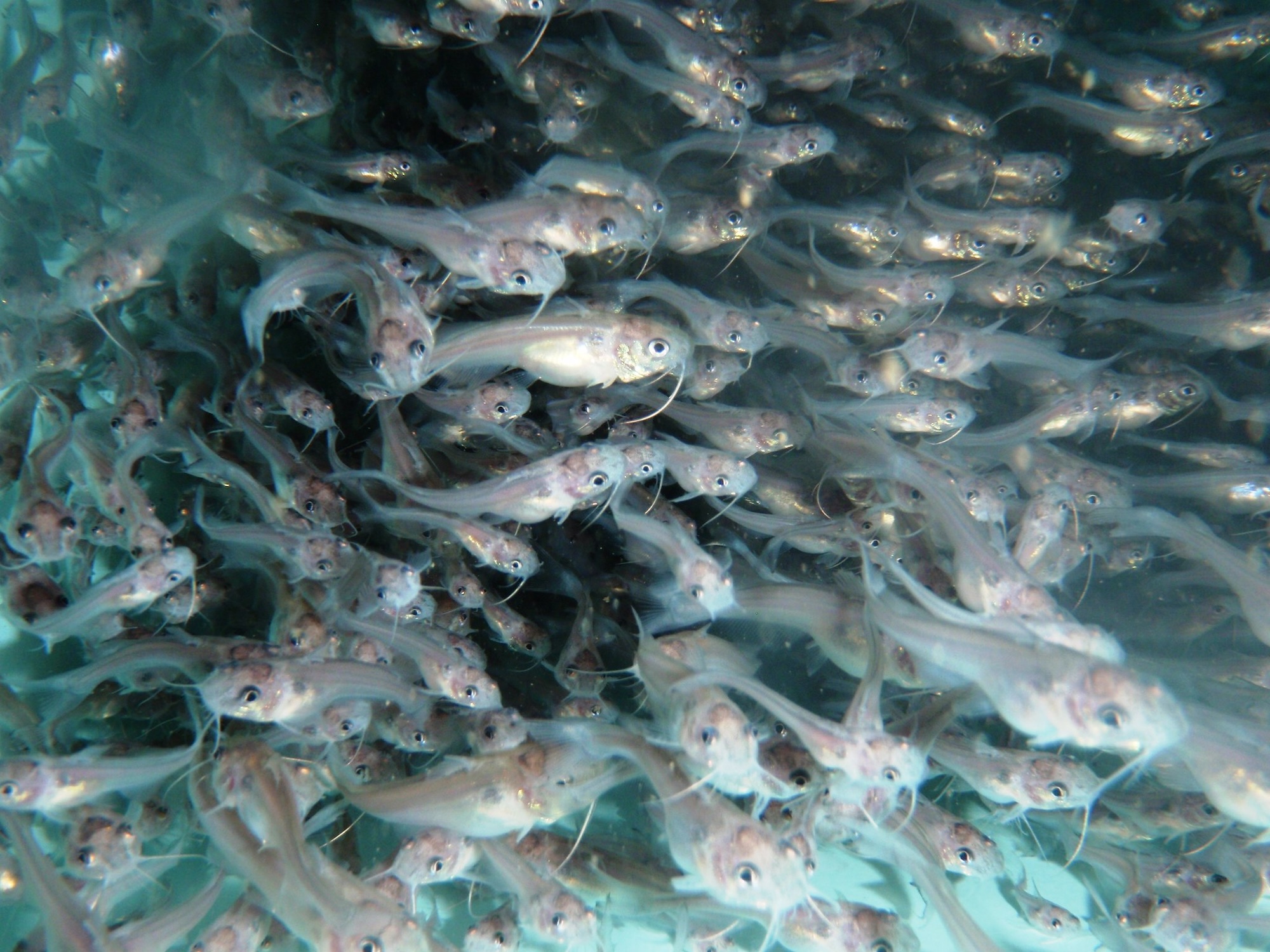
Little if any conclusive research exists on noodling’s impact on larger catfish populations, however, so most fisheries biologists are often reluctant to draw conclusions about the practice—for better or worse. For one thing, no one has been able to successfully quantify how many anglers are noodling, though most state biologists agree it’s a small fraction of licensed anglers. That uncertainty can make it difficult to set limits for noodling.
Previously in Oklahoma, noodlers were only allowed to keep three flathead catfish, while rod-and-reel anglers were allowed to keep 15.
“One thing we talked about internally was, if someone harvests a catfish, it’s still a harvested catfish,” says Cliff Sager, a senior fisheries biologist for the Oklahoma Department of Wildlife Conservation. “Does it matter if you catch it on a rod and reel and harvest it, or does it matter if you catch it with your hands and harvest it?”
Ultimately Oklahoma DWC determined it didn’t matter and changed the overall flathead limit to five fish per day—no matter the method of take, Sager says. “We went with a conservative number and didn’t really have any data to think that harvest during that spawning period was going to have massive detrimental effects to our population across the board.”
Additionally, many catfish noodlers practice catch-and-release. Noodlers often target trophy-size flatheads for the challenge rather than the filets, since bigger catfish aren’t the best eating. Often noodlers will catch the same fish out of the same hole multiple times in a season.
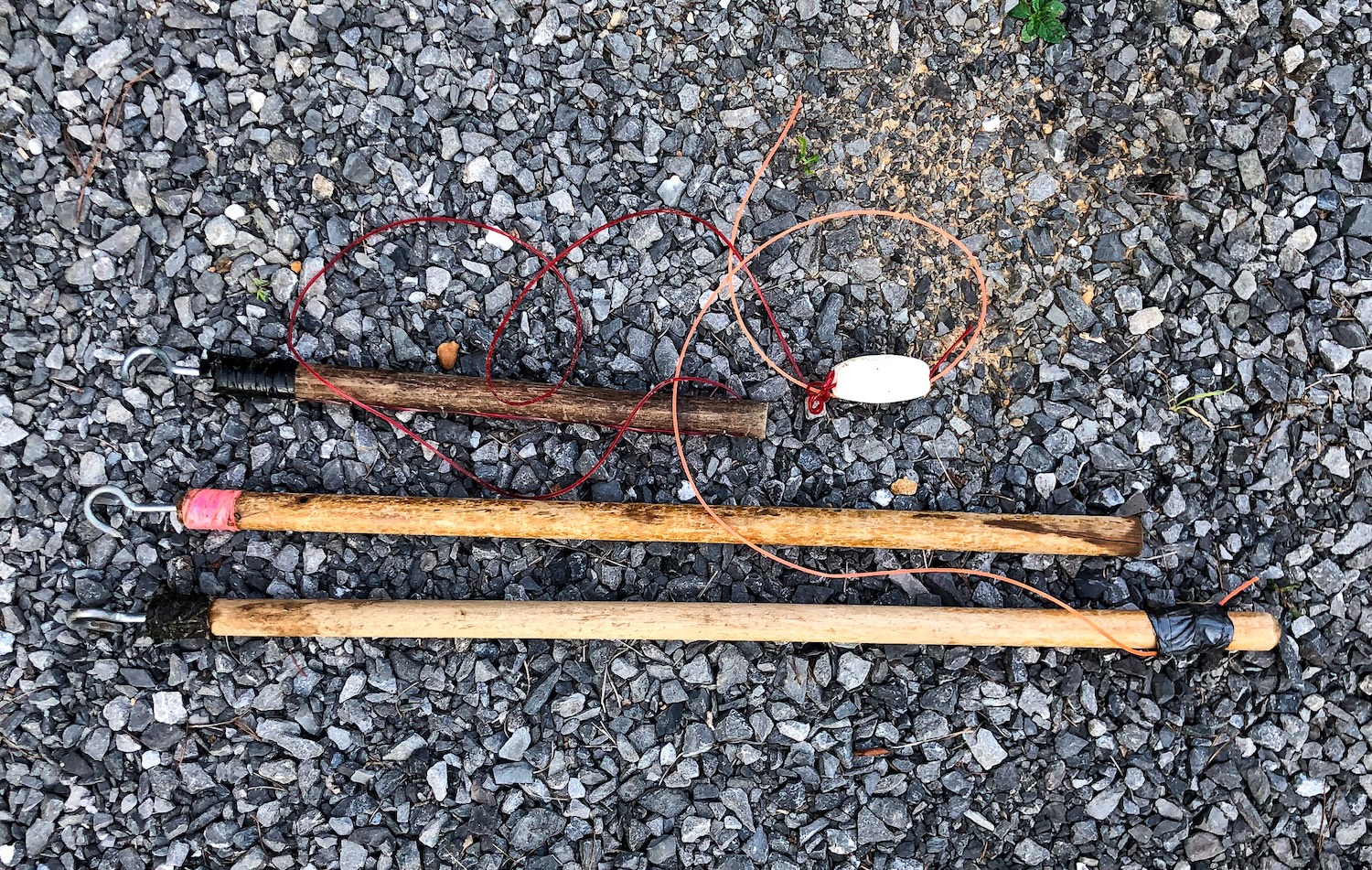
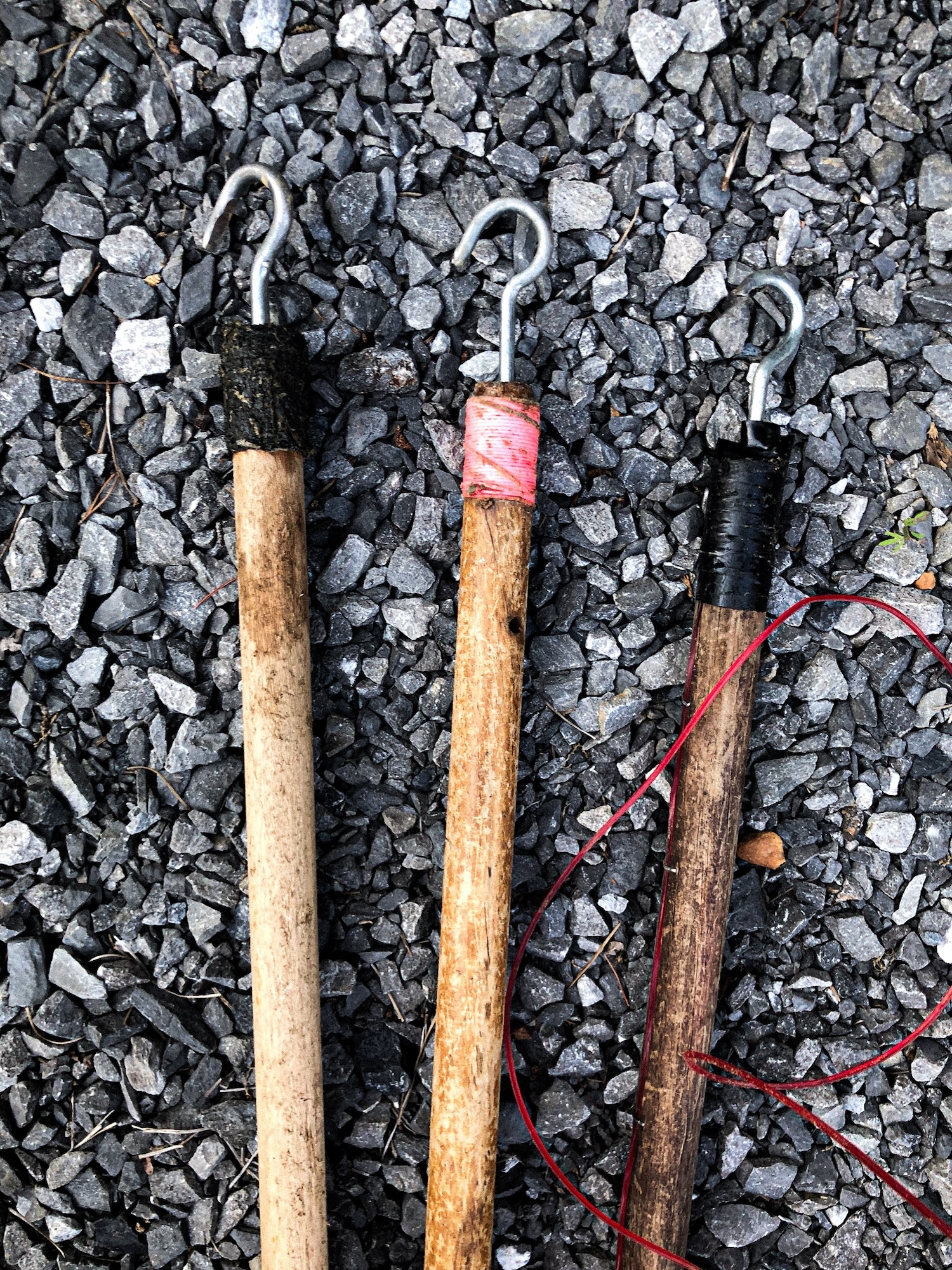
“Hand fishers reported catching about 8 catfish per day, yet harvesting only two or three,” concludes one of the few studies on noodling published by the Texas Parks and Wildlife Department in 2017. Almost all the Texans surveyed were already catfish fishermen who used other gear to catch cats; only 5.6 percent exclusively noodled.
“Results suggested that even though hand-fishers target large fish, harvest may not be a primary objective. The legal addition in 2011 of hand fishing in Texas does not appear to have recruited many new people to cat-fishing, and hand fishers were likely represented in previous statewide angler surveys as well as a 2010 statewide catfish survey. Thus, the overall impact of this style of fishing to Texas’ fisheries resources will likely be minimal.”
The bottom line? If you want to try noodling but you’re conflicted about removing catfish from spawning beds, handle them carefully and release them after a few quick photos. Catfish are tough critters with good catch-and-release survival rates.
Gear for Noodling Catfish
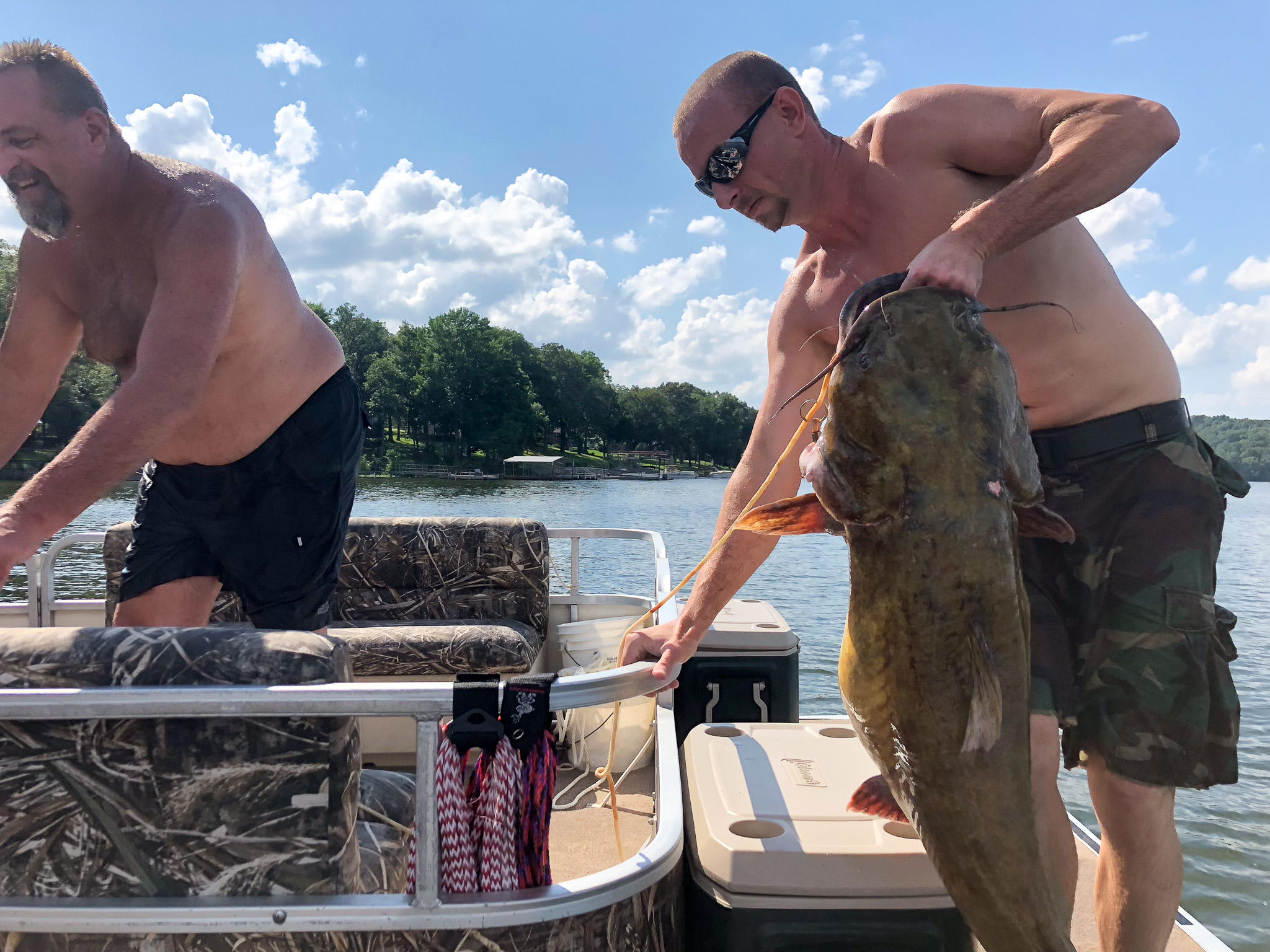
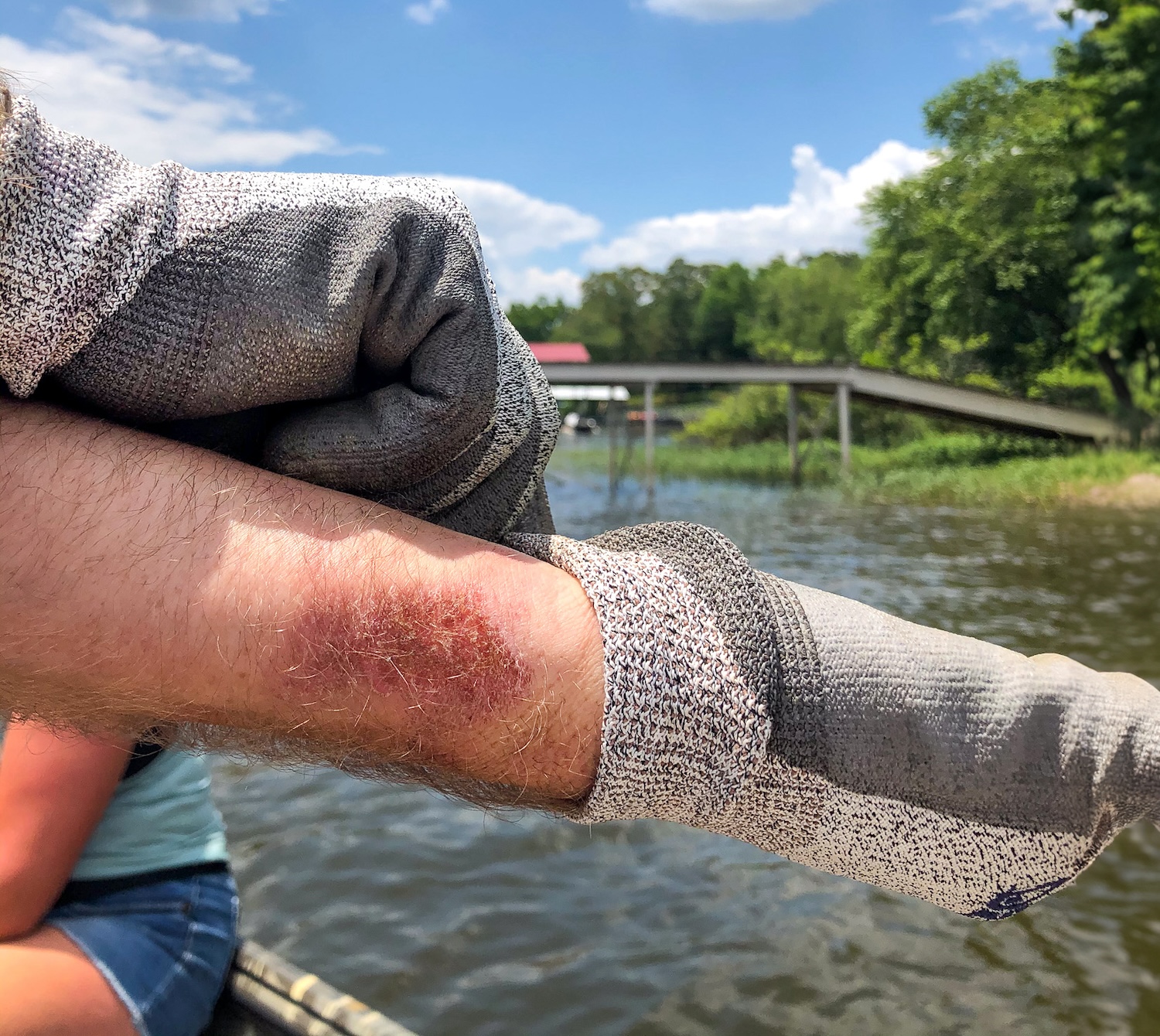
Unlike rod-and-reel fishing, noodling catfish requires very little gear since all you really need is your bare hands and a little nerve. Still, you’ll probably want to consider packing these items:
- Gloves. They’ll help you get a grip on a slippery cat and also protect your hands from rock rash and catfish bites. Popular options include tacky gardening gloves or cotton-knit shop gloves. (Vinyl and kevlar gloves tend to be too slippery.)
- These aren’t necessary, but it’s nice to have at least one on your dominant arm—especially in rockier spots.
- Stick or wooden broom handle of different lengths topped with hooks (where legal). You can fashion various lengths out of old broomsticks or heavy dowel rods and dull hooks. These help you reach catfish that are more than an arm’s length inside a catfish hole.
- Well-fitting swimsuit. Bear-hugging a thrashing catfish is a good way to lose your suit, so guys should plan to knot the waist strings on their trunks and gals should opt for a one-piece or more athletic top.
- Goggles. While most noodlers fish turbid water that renders goggles completely useless, some noodlers target catfish in clearer creeks where they could prove useful.
- Big net (where legal). Grabbing hold of an angry flathead is one thing; “landing” it while you’re up to your chest in a lake is another entirely. Keeping a buddy on standby with a net can help you hang onto your fish long enough for a photo.
- Rope or stringer. If you plan to keep any catfish, keep a stringer handy.
- Coolers and ice.
How to Catch a Catfish with Just Your Hands
Noodling catfish is simple in principle: Stick your hand in a catfish hole, let a fish grab on, and pull it to the surface. In practice, noodling is anything but. After you’ve scouted a likely spawning cavity (more on this below), follow these suggestions for the best chance of actually landing a catfish.
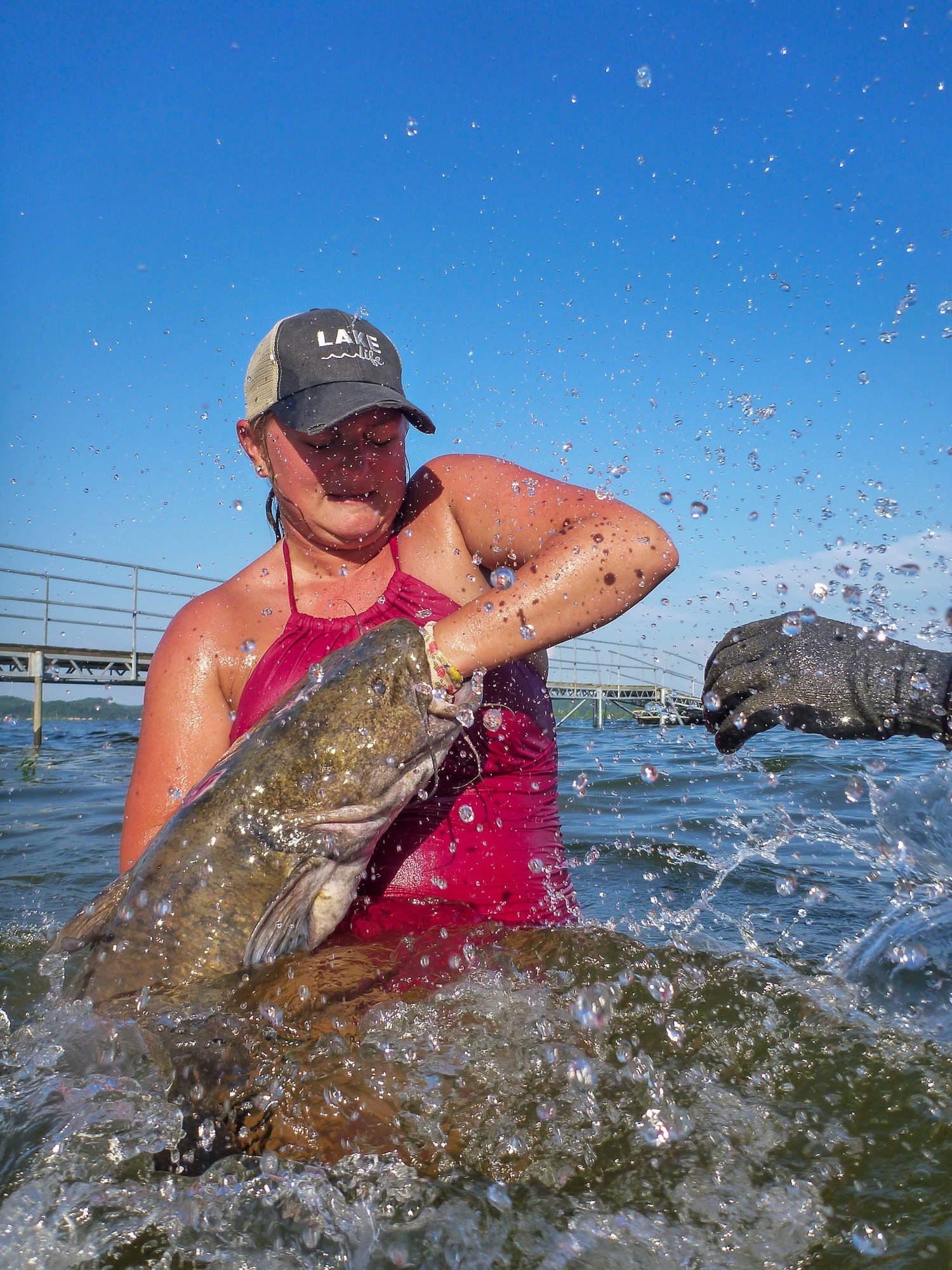
- Pull on your gloves. And a kevlar sleeve if you’re using one.
- Don’t let any fish that might be in the hole escape. Use your feet or your body to block the hole as you prepare to check it. If the hole is too wide for you to cover by yourself, enlist a buddy to help you block it.
- Take a deep breath. Depending on the catfish hole, you may need to dive or you might be able to keep your face above water. If you have to go underwater to check the hole, fill your lungs with air and hook your feet or opposite hand inside the hole to slingshot yourself down through the water and toward the opening.
- Run your hand inside the catfish hole. Reach your dominant hand into the hole, palm down, to check if there’s a fish inside.
- Expect to get smacked. When you do get bit by a catfish, it’s going to happen fast—so fast you probably won’t be able to grab it if you’re new to noodling. Still, do your best to curl your fingers around the lower jaw and hang on. You can try pinning the fish to the bottom of the hole and readjusting your grip for a better hold, then pull it toward you. Your ultimate goal is to get the fish out before you run out of air. Keep in mind that some spawning holes are larger than others, and the fish could potentially retreat into the back of a bigger cavity, making it impossible to reach if you miss the initial bite. (Note: In some states like Kentucky, it’s legal to use poles with blunt hooks to help extend your reach.)
- If you miss the bite or the fish won’t bite, plan to dive a couple times. Even if a catfish bites you instantly and you get a good grip on its jaw, it could take you much longer to haul a bigger fish out of its hole, especially if it’s wedged in one with a smaller opening. Be sure to keep the hole blocked every time you have to come up for air.
- Hug a catfish. If you do manage to pull a catfish out of a hole, do your best to hang on. Haul upward with the hand in its jaw, pulling the fish up and in toward your chest as you wrap your other arm around it.
- Enlist a buddy. Your pals should help you out here by spotting you and, if the fish is a big one, grabbing onto the tail. Trophy fish are powerful and very effective at flopping out of your grasp if their tail is unrestrained. Your buddy can also help support the fish for photos.
Noodling Catfish Tips for Newcomers
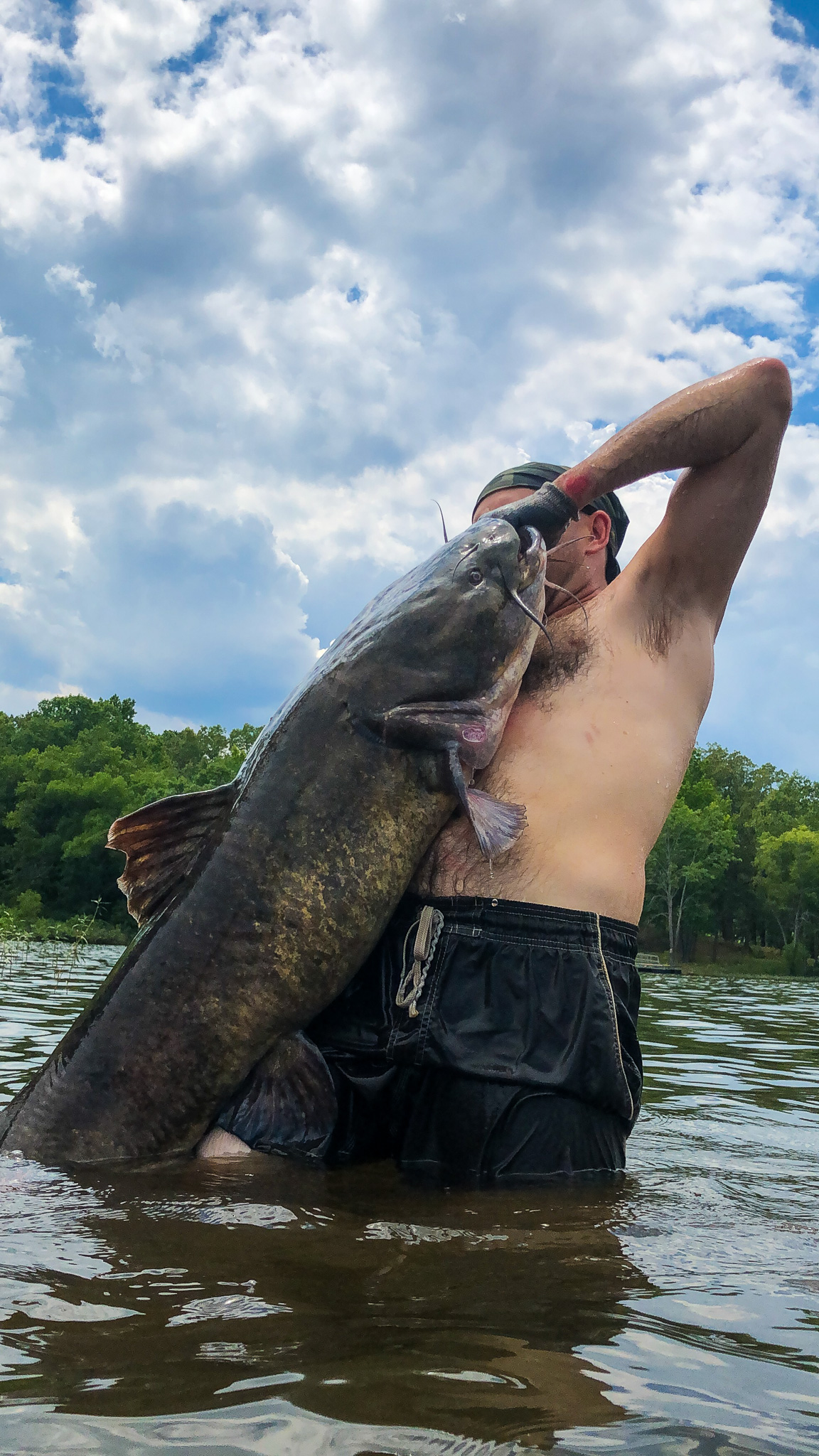
In the course of his work as a fisheries research biologist for the Oklahoma Department of Wildlife Conservation, Austin Griffin has noodled hundreds of channel catfish. When Griffin takes out new noodlers (including the occasional intern), he or another experienced noodler will check a hole first and then give the rookie a rundown of what to expect.
“I’ll give them an idea of what they’re getting into and tell them, like ‘Hey here’s one, it’s not real big, or it is big,’ whatever. Say ‘Hey, you’re gonna feel a pop. It’ll shock you but it’s not really hurting you.’ Just talk them through it.”
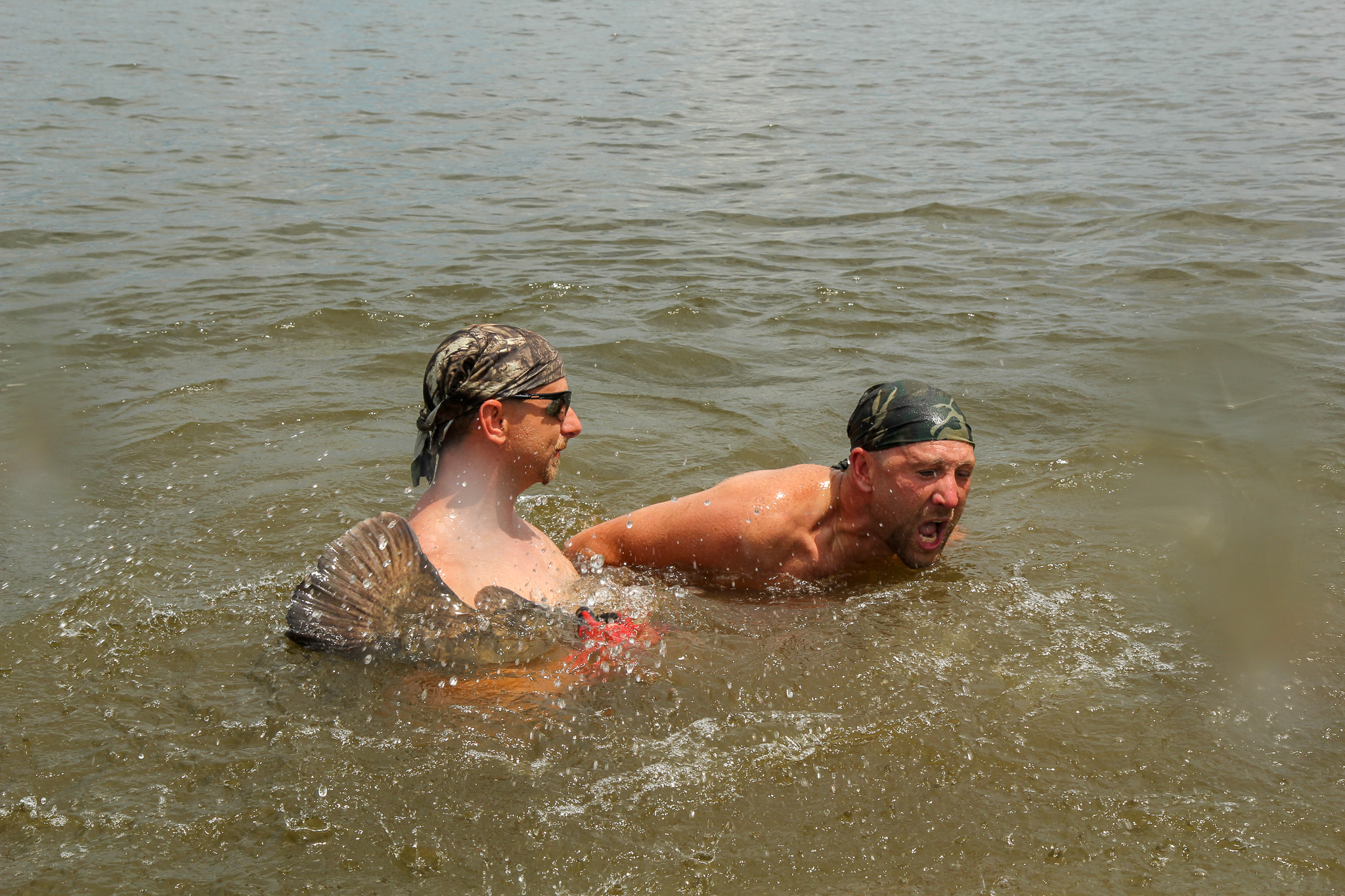
Although everyone talks about “getting bit,” sometimes a catfish just won’t bite. The first time I went noodling, I stuck my hand in a catfish hole and ended up petting a flathead.
“Maybe it’s a fish that’s just gotten in there and there’s no eggs yet. He’s just a male that’s getting [the hole] ready. Or if there’s a pair of fish in there but they haven’t laid eggs yet. This is just my opinion,” says Griffin, citing his noodling experience rather than research, “but they don’t seem to be quite as aggressive at that point. That’s when you gotta grab them. But [otherwise] they’re pretty aggressive. If there’s something in there to defend [like eggs or fry] they’re usually biting.”
When a catfish does strike your hand, it’s really more of a quick snap designed to stun and warn you off its spawning cavity. It can be difficult to get a grip on a cat’s jaw on the initial bite if you don’t know what to expect. If you miss your chance, sometimes you can feel around for the fish, find its lower jaw, work your hand in there, and pull it out.
Catfish Handling Tips for Catch-and-Release
Catfish are notoriously tough fish (they’ve been around for 70 million years), and they can generally handle the rodeo that is noodling. Fish often get scraped up when you pull them out of natural holes, especially on their backs. This isn’t a big deal, says Griffin.
“We’ve pulled some catfish out that look piebald, they’re missing so much [skin] just from being in there and spawning. They’re doing it to themselves so I wouldn’t worry about that too much.”
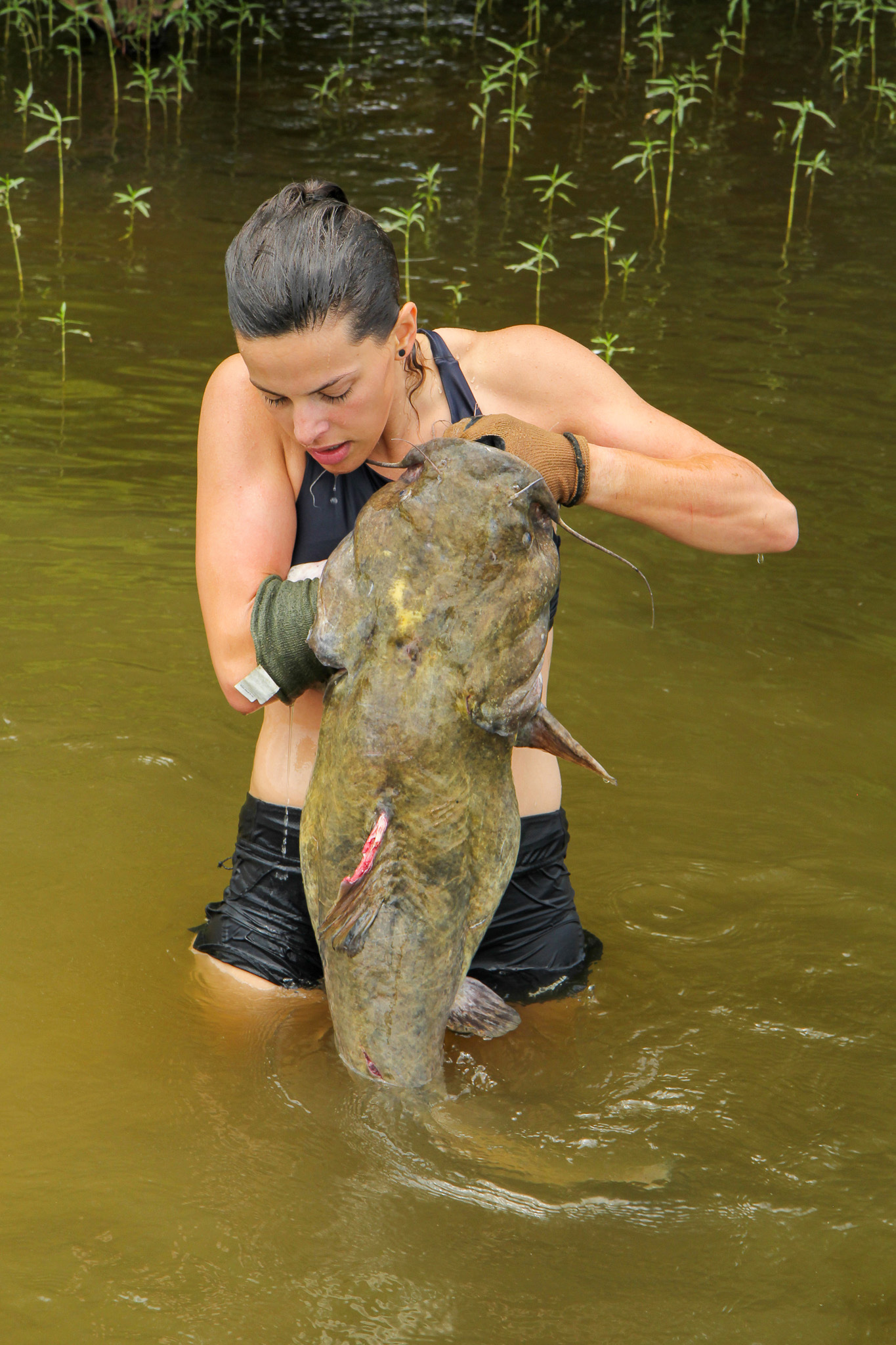
Still, it’s important to handle any fish you plan to release carefully. Where legal, Griffin recommends having a buddy on standby with a net. If nets aren’t legal and you need a good grip on a big fish, you can carefully thread your hand through its gill plate and create a sort of human stringer with your arms.
“If you do it right on the bigger fish, yes you can come in backwards [with a hand] through the gill plate and grab it. I’ve definitely done that before and I don’t believe it caused an issue. But if you’re trying to do that on small fish and you’re just tearing gills up, that’s obviously a problem.”
If you do damage the gill plate, keep the fish instead of throwing it back. I was so determined not to lose the first couple of catfish I noodled that I damaged a few gill plates, earning myself filets for the freezer and a new nickname from my buddy: the Black Widow.
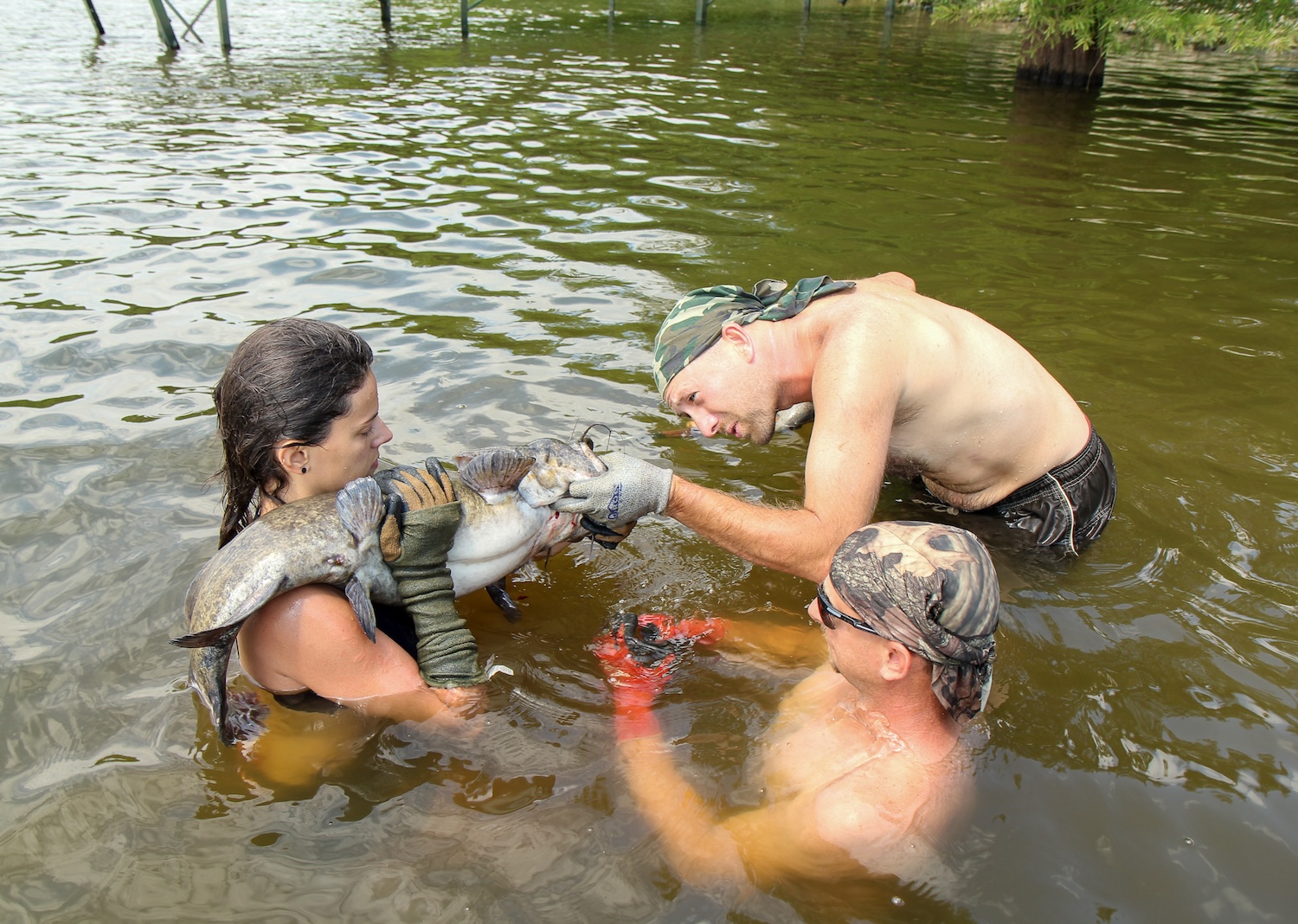
“The main thing … when you’re taking your pictures, just try and support that fish,” advises Griffin. “Don’t just hold it up by the bottom jaw, kind of cradle it under your arm or even if you’re small and it’s big enough, give it a kind of bear hug.”
Is Noodling Catfish Dangerous?
When I made the mistake of mentioning to my mom that I was going noodling, she pictured a massive catfish clamping onto my entire arm until I drowned in a murky cave, never to be seen again. In reality, noodling catfish is like most outdoor pursuits: it’s as safe or dangerous as you make it.
There’s little to no available data about the safety of noodling. Any major injury or fatality rates likely have more to do with the usual risks of swimming, boating, and beer drinking in natural bodies of water. It’s theoretically possible, though improbable, to knock yourself out on a rock or for riprap to shift and pin you underwater.
Even so, it’s a good idea to always noodle catfish with a buddy. They can help you subdue a fish, sure, but they can also check on you if you don’t resurface when expected. If you can’t convince anyone to go noodling with you, consider hiring a guide. There are a handful of specialized guides in areas where noodling is legal and productive.
Wrestling Catfish Underwater
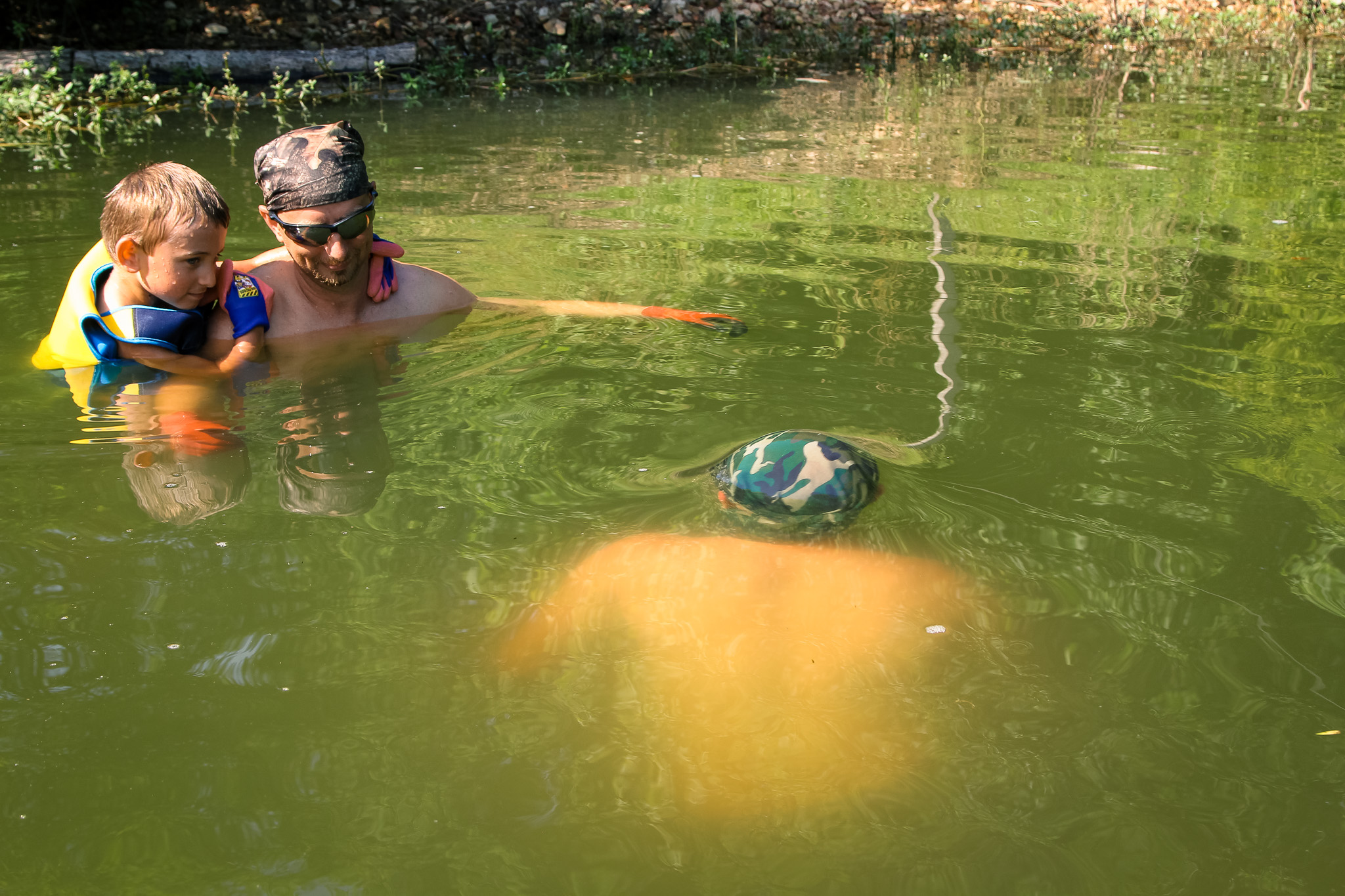
For one thing, catfish don’t actually hang on when they bite—just the opposite.
The whole point of noodling is trying to hold onto a giant bucking catfish and wrestle it to the surface without it slipping from your arms. Most catfish, no matter how angry, don’t want anything to do with you. If given the chance, cornered catfish will often squirt out of the entrance to their cavity (another reason it’s important to block the entrance with your body or enlist a buddy) or, on the rare occasion they have one, a secondary exit.
It is possible to noodle catfish without going underwater. While some veteran noodlers are comfortable diving anywhere from three to 10 feet to check a spot, I’ve also fished with one experienced noodler who preferred to keep her face above water so she could breathe while reaching into shallow spawning beds. She still caught plenty of big flatheads.
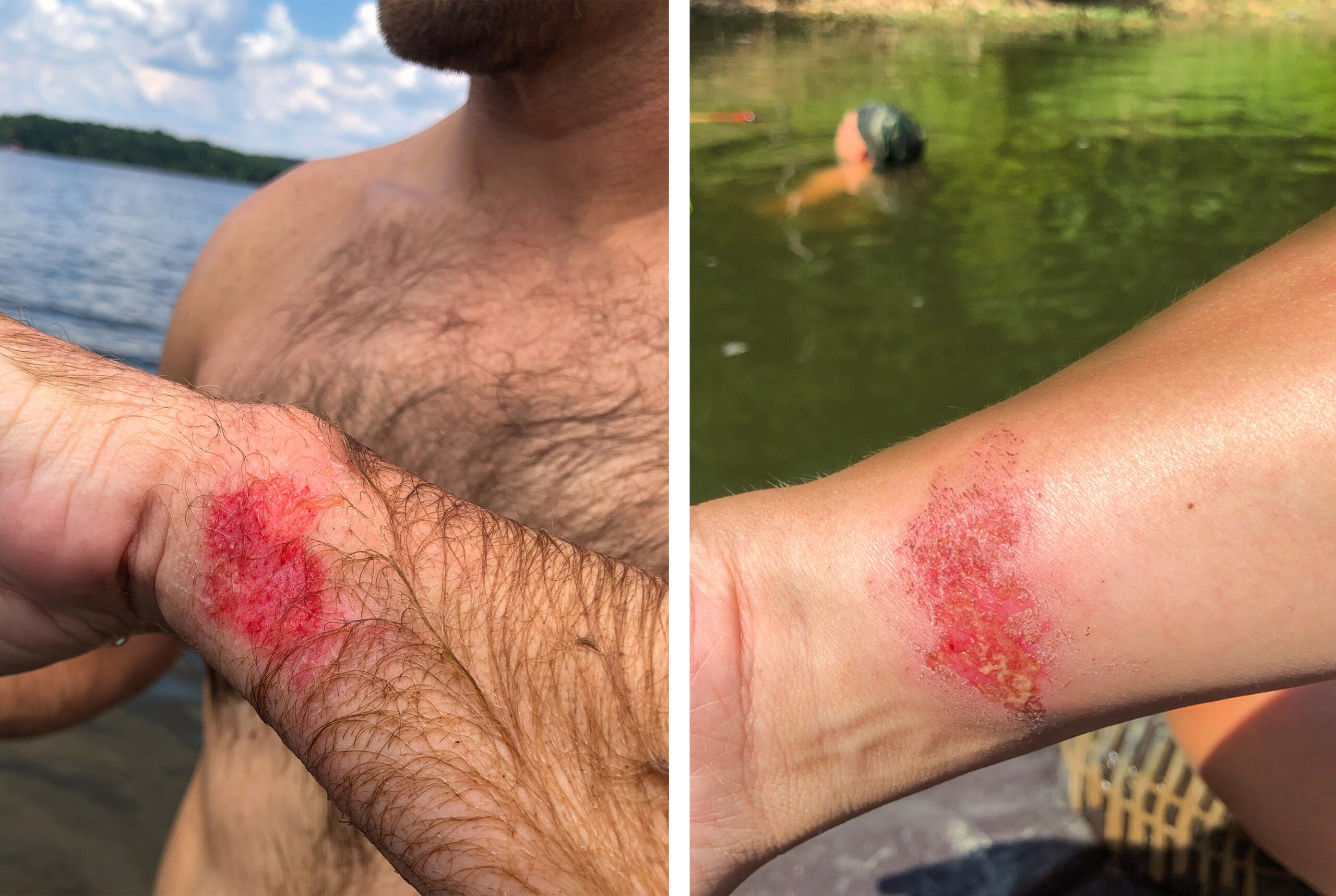
You’re Going to Get Scraped Up
Your most likely injury while noodling catfish is scraping up your hands and arms, both on a fish’s mouth and from the rocks of its spawning cavity. This is why many noodlers prefer to wear a pair of gloves and kevlar sleeves. Catfish make spawning cavities in all kinds of places, so check likely catfish holes for sharp rocks, trash, scrap metal, rebar, fishing line, and other hazards before getting after it.
Additionally, all three catfish species that you may encounter while noodling—flatheads, blues, and channel catfish—have sharp spines on the front of both pectoral fins and the dorsal fin, which means you could get stuck while fighting a fish. This isn’t a major concern for the noodlers I’ve spoken with, but if you’re wary of getting stung, wear gloves and do your best to avoid channel cats, which have the worst barbs.
“We’ve caught hundreds [of channel cats] and it hasn’t really been too much of an issue,” says Griffin. “You get a little cut up, but nothing crazy.”
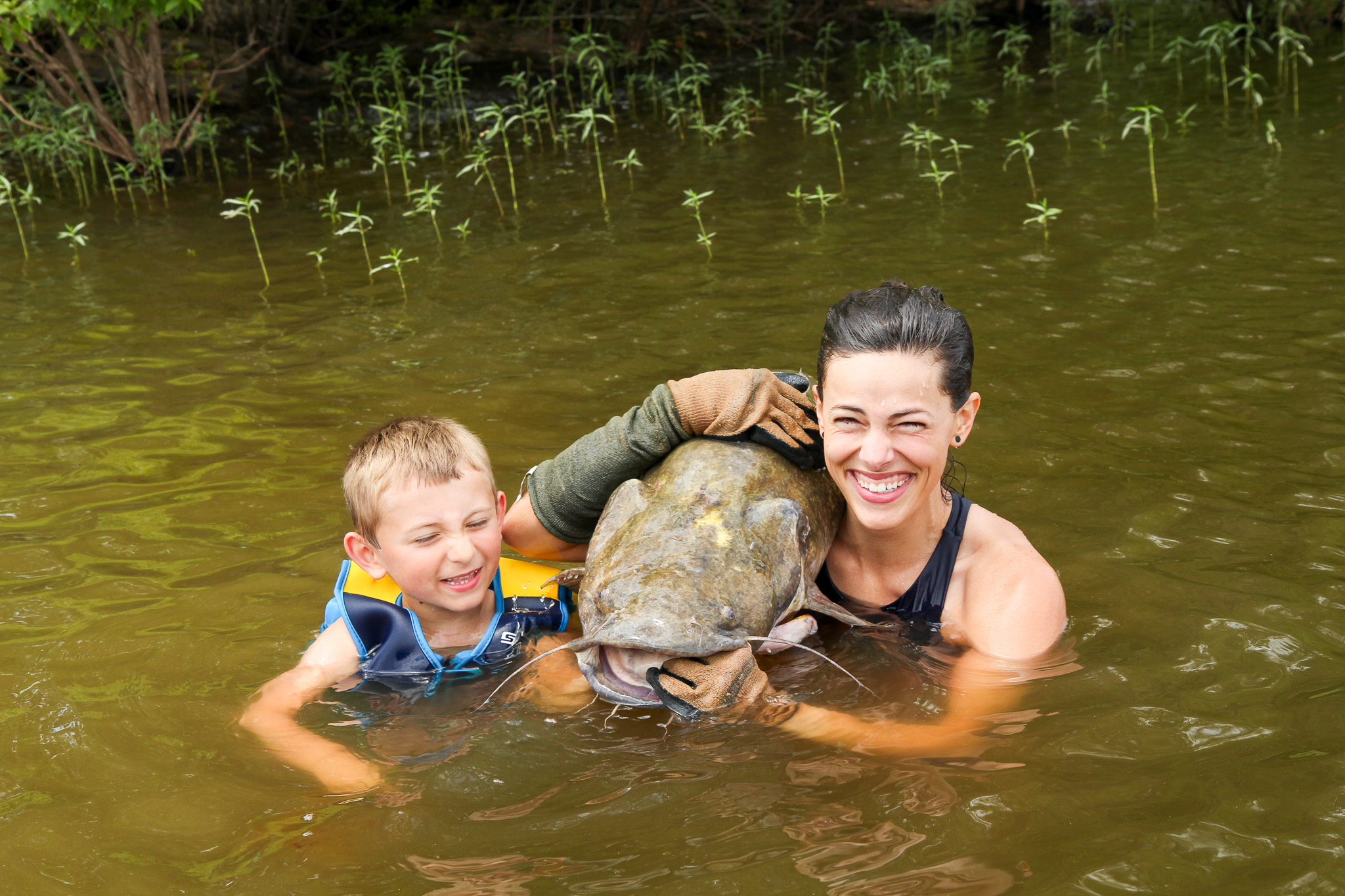
What About Turtles, Snakes, and Beavers?
While most noodling skeptics are convinced they’ll end up with a snapping turtle clamped to the bloody stump that used to be their hand, the risk is minimal. The key to keeping all your limbs is to target spawning cavities that are fully submerged. Turtles, snakes, and mammals like beavers and muskrats all need to breathe (eventually), and they tend to hang out in places with air pockets, according to Brantley. If the holes you’re checking are truly underwater, the risk of grabbing a turtle or snake while noodling catfish is relatively low.
Read Next: The Best Catfish Rods
“People always say, ‘Oh, I don’t wanna stick my hand in a hole and get bit by a turtle. I don’t want to stick my hand in a hole and get bit by a beaver.’ I don’t know of anyone who’s ever been bitten by a turtle or a beaver,” says Sager, who has worked as a fisheries biologist for 21 years. “I know a lot of people that go noodling. I still haven’t found the guy with nine fingers.”
(Some noodlers intentionally target turtles, and it’s legal to noodle several turtle species in some states, including Indiana, though the Hoosier State does not allow catfish noodling.)
Understand Catfish Spawning Behavior to Find Fish
To pinpoint productive spots for noodling catfish, it’s important to understand how and when catfish spawn.
“The catfish that people are primarily noodling for—flathead catfish, blue catfish, even some channel catfish—are generally cavity spawners,” says Sager. “And so the male is finding a cavity, a hole, in the bank of a river. At least here in Oklahoma, a lot of our rivers have clay banks and they’ll have natural holes or depressions in them that the catfish will use for their spawning activity. What they’re looking for is a place that’s secure, where that fish feels like it can guard the nest.”
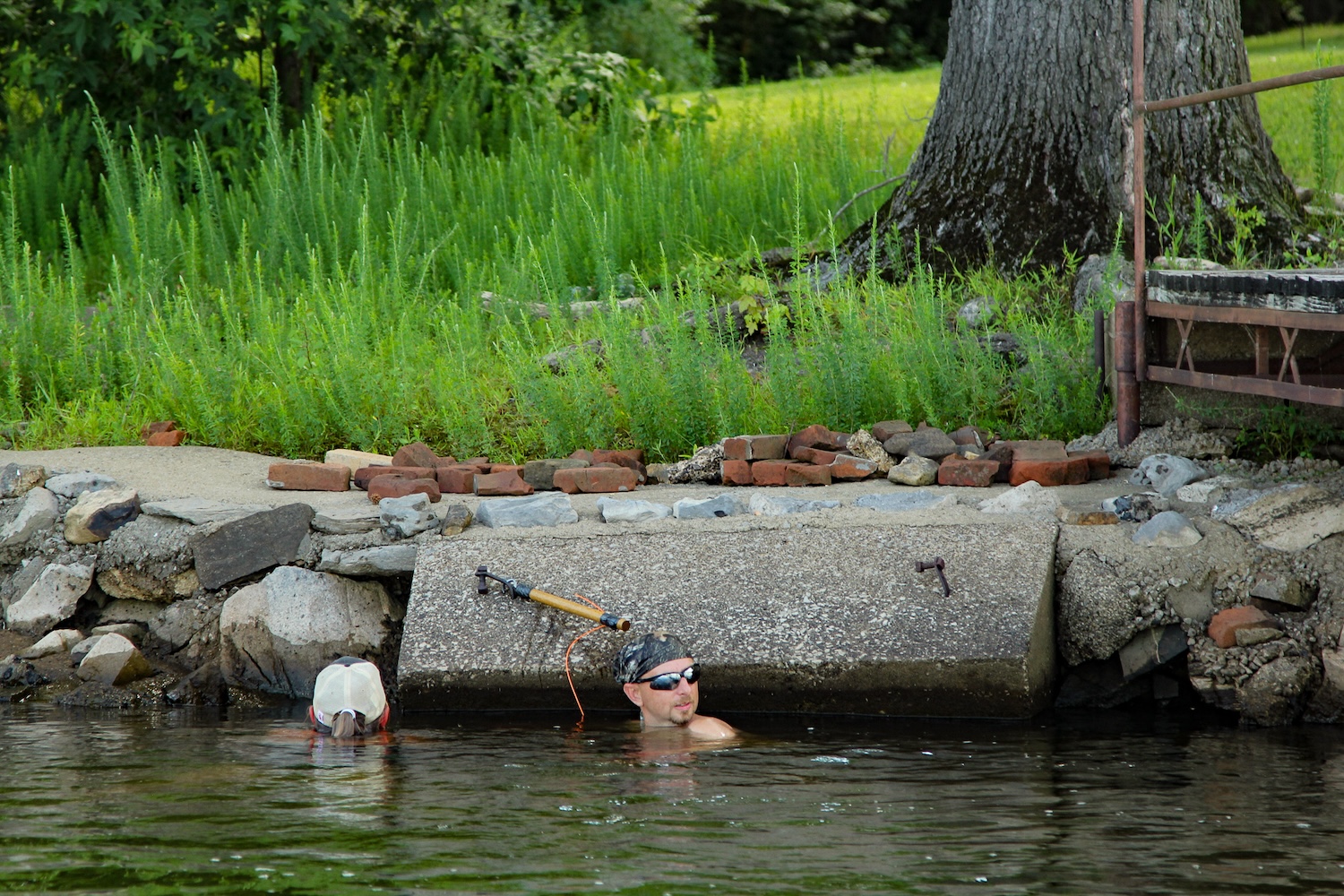
Places catfish make their spawning cavities include:
- Riverbank and creek bank holes
- Hollowed out logs
- Submerged rootballs
- Under large rocks or concrete
- Riprap
- Man-made spawning boxes (these are only legal to noodle in some states)
Once a male catfish finds a suitable cavity, he’ll clean it and even enlarge it by fanning silt and sediment from the bottom.
“Then the female comes in, lays eggs in that nest, the male fertilizes them and then guards them,” says Sager. “The male will fan the nest to keep the sediment from covering them up and keep oxygenated water coming to those eggs so they can develop and hatch.”
The optimal time of year for noodling depends on the water temperature. Most season dates are set to coincide with, or fall just after, the catfish spawn in the spring. That usually means late May through July, depending where you fish.
“The spawning temperature is a fairly wide range from 70- to 80-degree water temperatures is what’s kind of acknowledged for catfish, especially flatheads,” says Sager. “Some years water temps come up very quickly and that window of opportunity [to find catfish in spawning cavities] is gonna be narrow. Other years it doesn’t come up as fast and there may be a longer spawning window.”
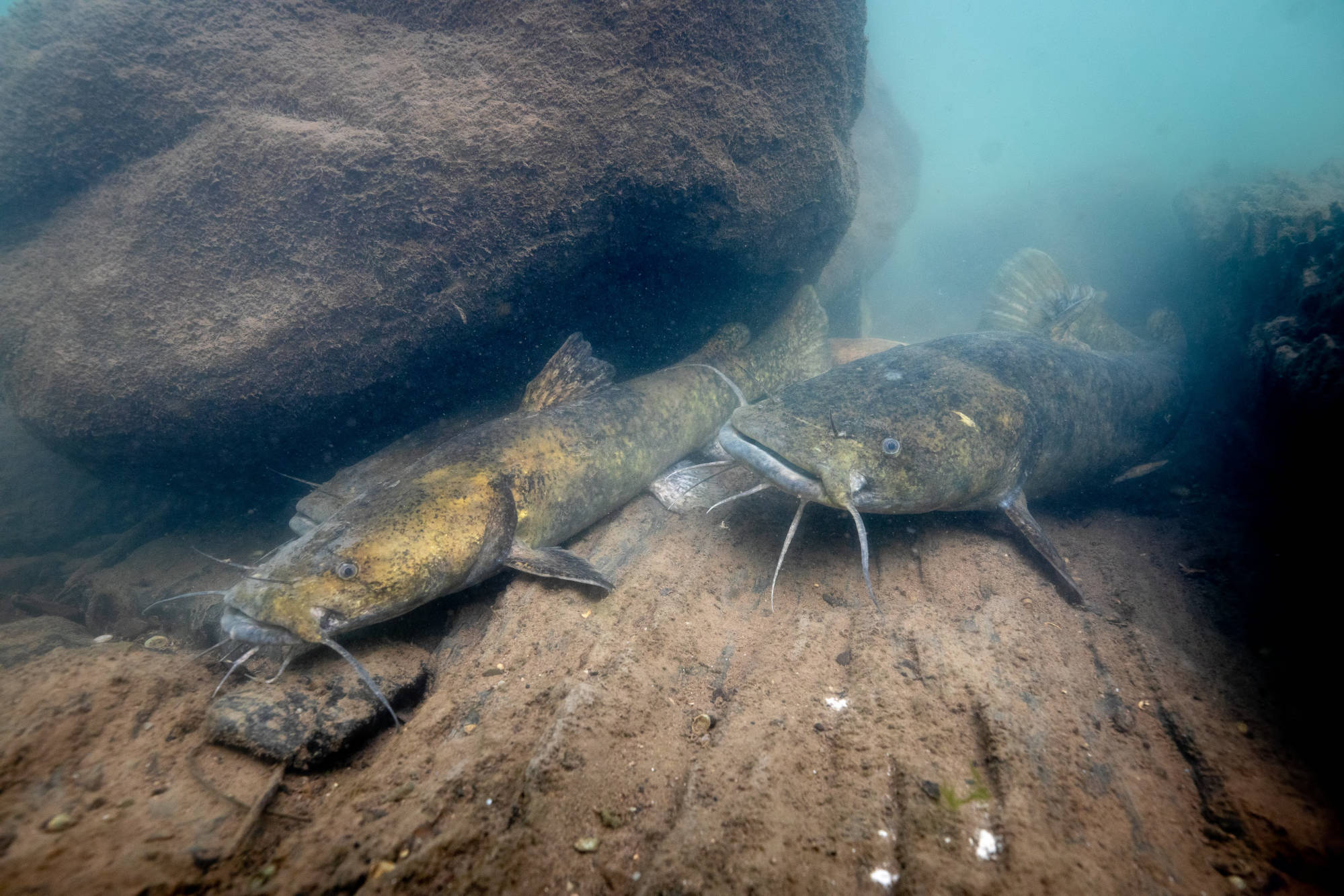
Blues, Flatheads, and Channel Cats
The most popular catfish species noodlers target are flathead catfish, though noodlers will often target (or accidentally catch) blues and channel cats, too. Assuming that all three species are present in the water body you’re fishing, says Griffin, any catfish hole you check could have any of the three species inside. The timing of your noodling trip is more likely to dictate which catfish you might find.
“Generally speaking here [in Oklahoma] it seems like mid- to late May, the channels and blues are already going and that kind of peaks around mid-June,” says Griffin. “It’s all dependent on the year, but say in a normal year with normal weather, it’s not until the mid-June timeframe before the flathead [spawn is] even really picking up.”
So if you want to target flatheads, consider noodling later in the spawning season. If you’re hoping to catch channel cats or blues, try earlier. You may also find two catfish—a male and a female—in a single spawning cavity depending on your timing. Sometimes that’s two flatheads, channel cats, or blues, but occasionally you can find two species.
“There’s definitely occasions where we found blues and channels mixed in the same hole,” says Griffin. “Which makes sense, they’re the same genus. They can hybridize theoretically in the wild—they do it in hatchery settings all the time.”
You can find guides to identifying each subspecies of catfish here.
- Channel catfish are smaller, and hard-fighting
- Flathead catfish are medium-sized catfish, and the primary target of noodlers
- Blue catfish are the biggest in North America, and are known for having a harder bite than flatheads
While any flathead is going to bite you if it’s guarding a nest, noodlers say they’re not as aggressive as their cousins.
“Blues and channels, their bite is definitely a lot higher PSI,” says Griffin. “It’s more like a clamp.”
Artificial Spawning Boxes for Catfish

Griffin and his colleagues are currently measuring the openings of natural channel cat hidey-holes and using those measurements to design better artificial catfish spawning boxes “instead of just throwing a box out there with a big old opening that’s real hard for a fish to defend.” The goal, Griffin says, is to build a better spawning box to help grow a self-sustaining population of channel cats and reduce the need for restocking. His findings are preliminary, but they do have implications for trophy catfish seekers.
“That vertical measurement [of a natural spawning hole] correlates pretty well with the fish’s maximum height. The horizontal measurement not as much, but that makes sense because most of these things are spawning under something that’s wide and flat.”
In other words, if you find a spawning cavity with a relatively tall opening, there’s a good chance there’s a big fish lurking inside. (While Griffin can legally check spawning boxes as a researcher, the practice is illegal for recreational noodlers in Oklahoma and in some other states.)
The Rise of Noodling Culture
Noodling might seem like another fishing fad, but it’s older than the United States—if not hundreds or thousands of years older. One of the earliest written accounts of hand-fishing for catfish was recorded by trader James Adair in his 1775 book, “History of the American Indians.” It’s unclear which tribe he was referring to in the following passage (Adair traded with the Cherokee and Chocktaw, and lived with the Chickasaw in the Southeast), but the fishing technique sounds an awful lot like modern noodling:
“They have a surprising method of fishing under the edges of rocks, that stand over deep places of a river. There, they pull off their red breeches, or their long slip of Stroud cloth, and wrapping it round their arm, so as to reach to the lower part of the palm of their right hand, they dive under the rock where the large cat-fish lie to shelter themselves from the scorching beams of the sun, and to watch for prey: as soon as those fierce aquatic animals see that tempting bait, they immediately seize it with the greatest violence, in order to swallow it. This is the time for the diver to improve the favourable opportunity: he accordingly opens his hand, seizes the voracious fish by his tender parts, hath a sharp struggle with it against the crevices of the rock, and at last brings it safe ashore.”
Noodling soon entered controversial territory (where it remains today) as an uncivilized way of catching fish, and was banned in Missouri in 1919 during an era of vigorous wildlife regulation. It was outlawed in the same law that forbade dropping rocks and logs on catfish, which tells you what fisheries managers thought of the practice.
“[Noodlers have] been characterized as poachers, villains, outlaws and so forth,” assistant professor Mark Morgan in the University of Missouri’s Department of Parks, Recreation and Tourism said after conducting a noodling study in the early 2000s. “But there’s a different dimension to hand fishing that other people might want to know something about.”
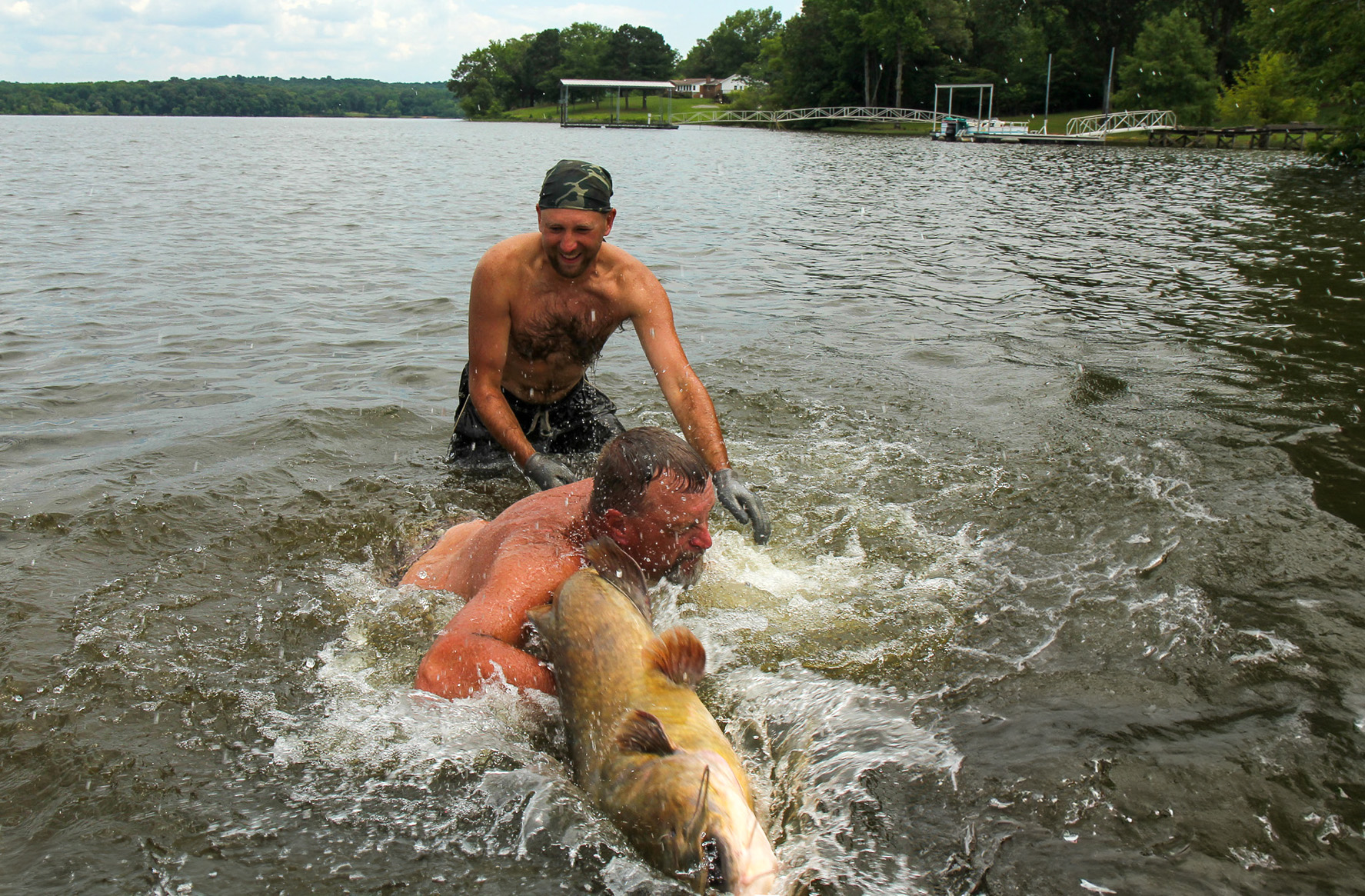
That dimension is that noodling is fun as hell, and challenging. The modern resurgence of noodling is largely credited to the 2001 documentary Okie Noodling, which followed several Oklahoma noodlers and showcased the subculture in a state that’s the indisputable OG of grabbing catfish. A legendary competitive noodling tournament is also held in Oklahoma each year.
But arguably the most visible promoters of noodling have been outdoor TV and social media influencers. After all, catfish noodling is perfect for the social media age. It’s impossible not to watch a half-naked person of questionable sanity grapple with a 60-pound flathead. Still, the popularity of the practice is tricky to gauge: Noodling might have gotten more press, but the number of permanent converts to this way of catfishing seems minimal.
“It’s really hard to try to quantify the number of people that go out and [noodle catfish]. We suspect it’s a pretty small percentage of our total number of anglers, but a small percentage of a very large number, so there’s still a lot of people out there,” says Sager. “Our suspicion is, yes [noodling] has increased. If it has increased, I think the obvious reason is because of social media. People are posting pictures of giant fish. Here in Oklahoma … we definitely have seen an increase over traditional … noodling pressure.”
FAQs for Noodling Catfish
While noodling is the most universally recognized term for catching catfish by hand, there are plenty of ways to describe the fishing technique. Most are regional terms; a few are universally accepted. Other names for noodling include tickling, grabbing, grabbling, hand grabbing, hogging, dogging, graveling, stumping, handfishing, hillbilly handfishing, and outlaw fishing.
A catfish noodler is someone who wades or swims into freshwater to catch cavity-dwelling catfish with their hands, or with the aid of poles or hooks.
The biggest documented catfish caught by hand is probably a 106-pound Texas flathead that was noodled by an Oklahoma man in 2021, though that fish was never weighed on certified scales. In June 2023, two Texas men caught a 98.7-pound flathead catfish by hand that might become a Texas state record since the fish was weighed on certified scales. Those men used a dive device to allow them to breathe underwater, however, which is not a traditional practice in the noodling community and therefore complicates their potential record. Few, if any states, keep noodling records, and the International Game Fish Association does not appear to recognize the method.
Final Thoughts
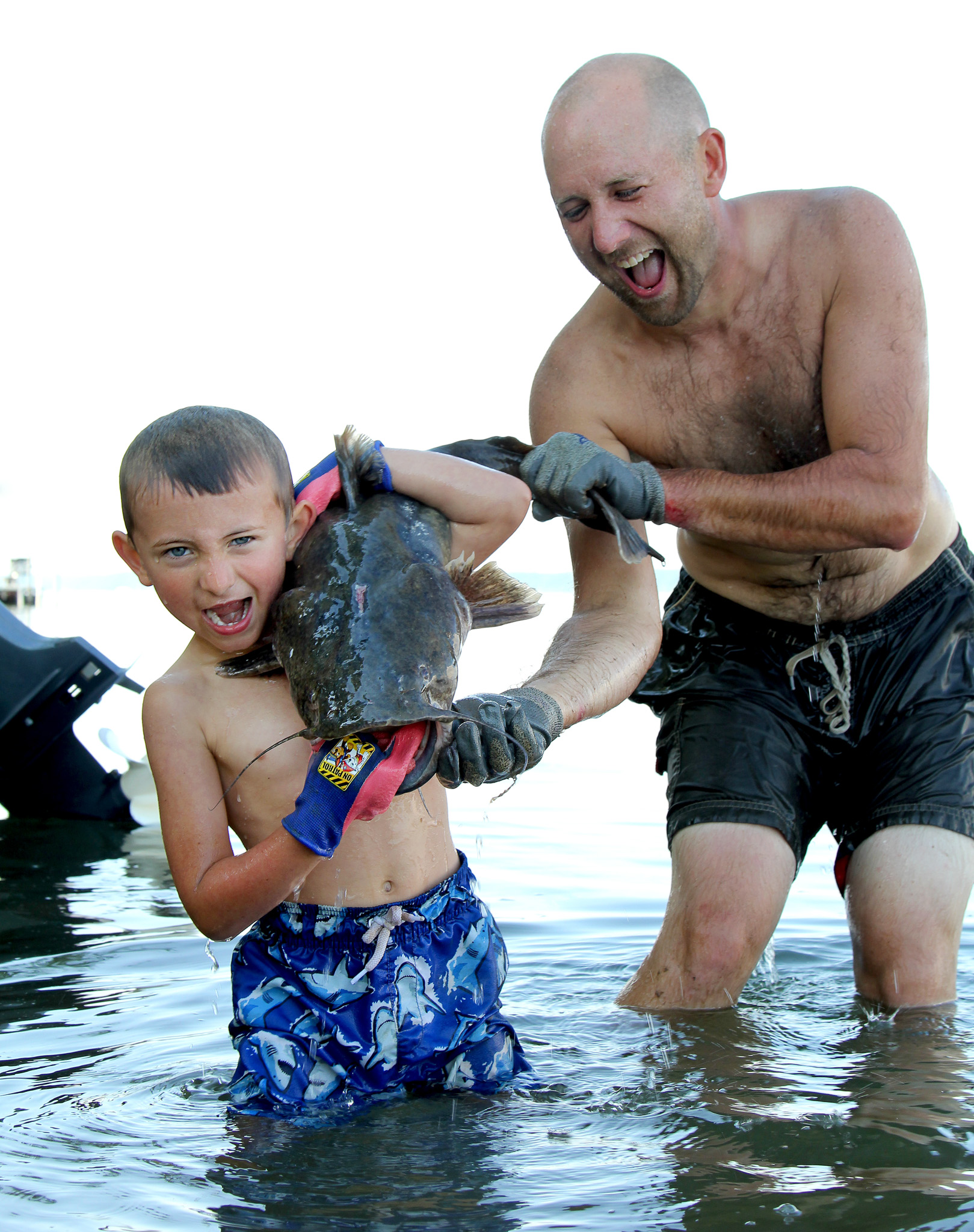
Noodling catfish isn’t for everyone, but if you’re an adrenaline junky who isn’t fazed by underwater arm wrestling with prehistoric critters, give it a go. Just be sure you’re hand fishing in a state and water body where it’s legal, and within the legal season dates—usually late spring through summer in most places.
And remember: When it comes to noodling catfish, there are three kinds of people. There are those who think noodlers are unhinged hillbillies and will never, ever try it. (Fortunately noodling is a great spectator sport, so if you’re in this camp, don’t miss an opportunity to tag along on the boat and watch chaos reign.) There are those who are willing to try it just once, but never again. And then there are those crazy folks who try noodling just once—and never look back.

